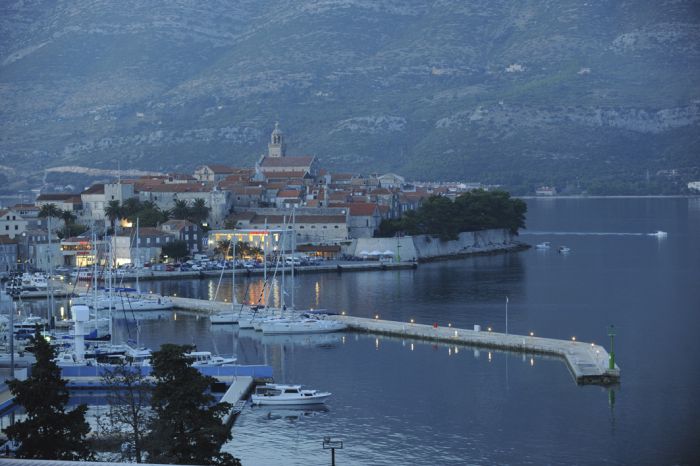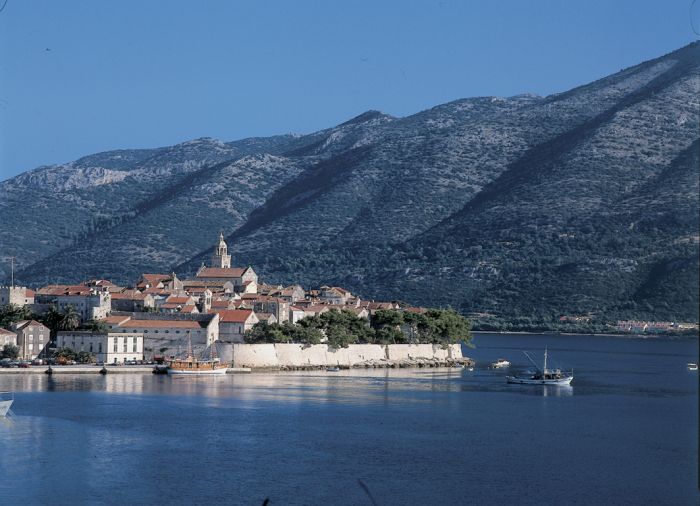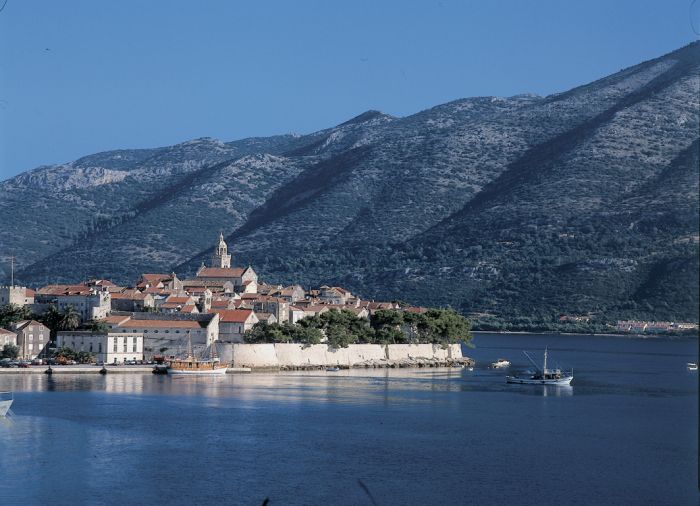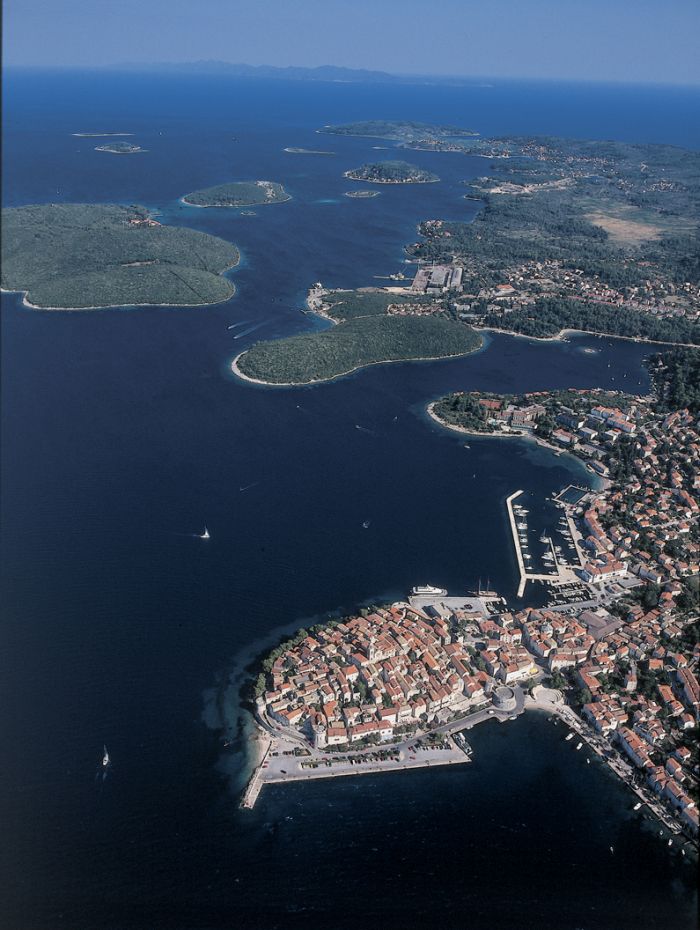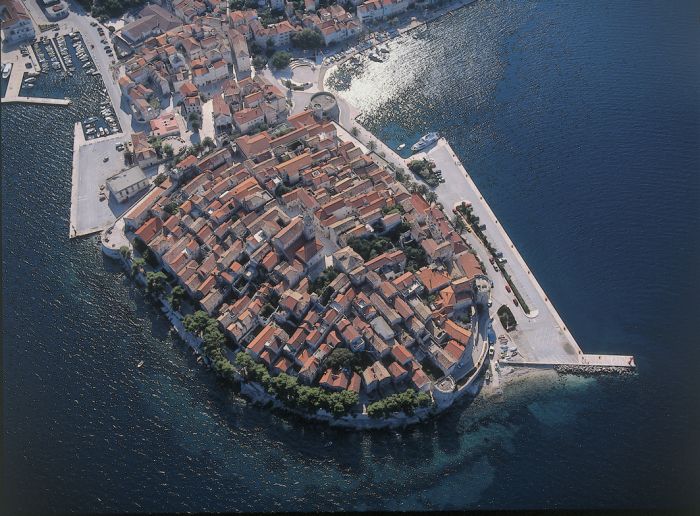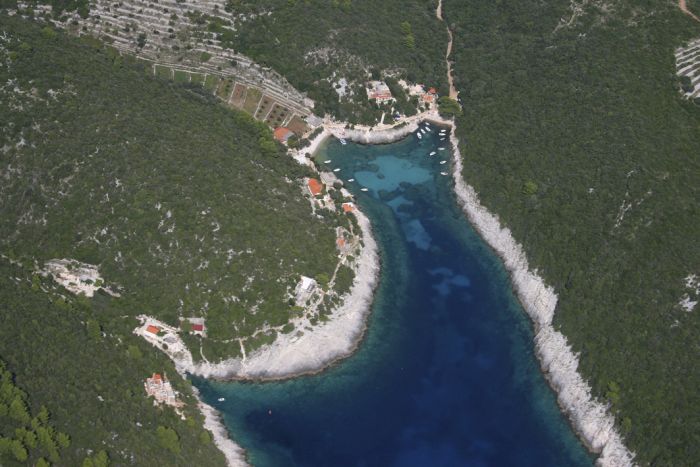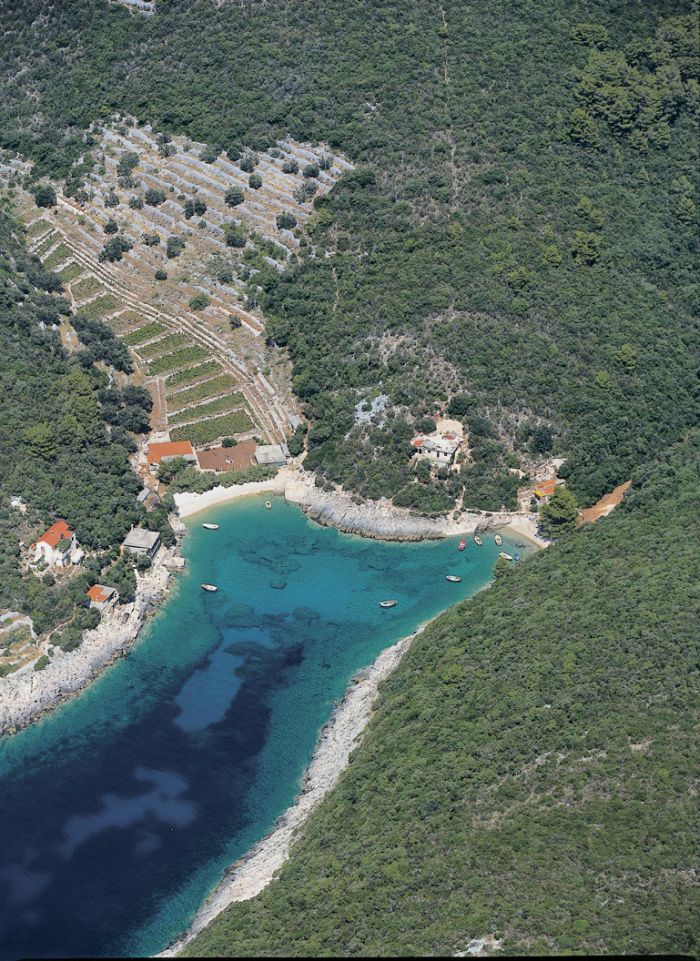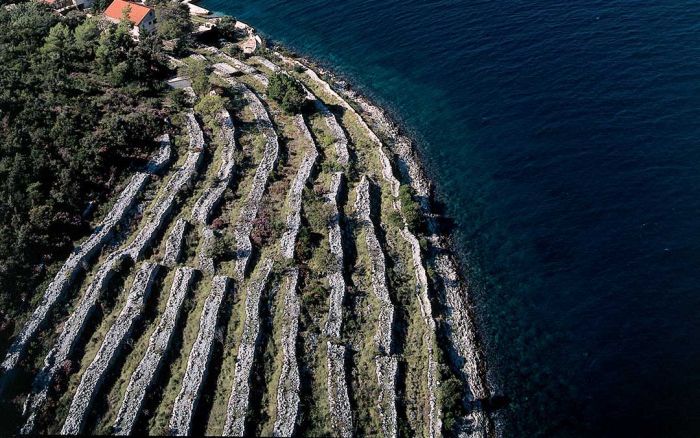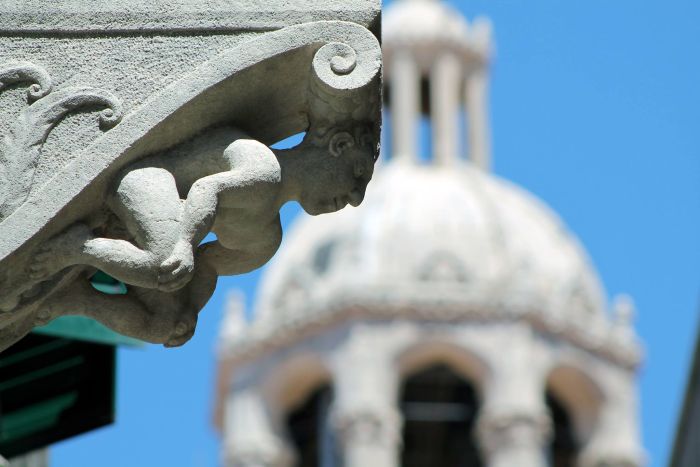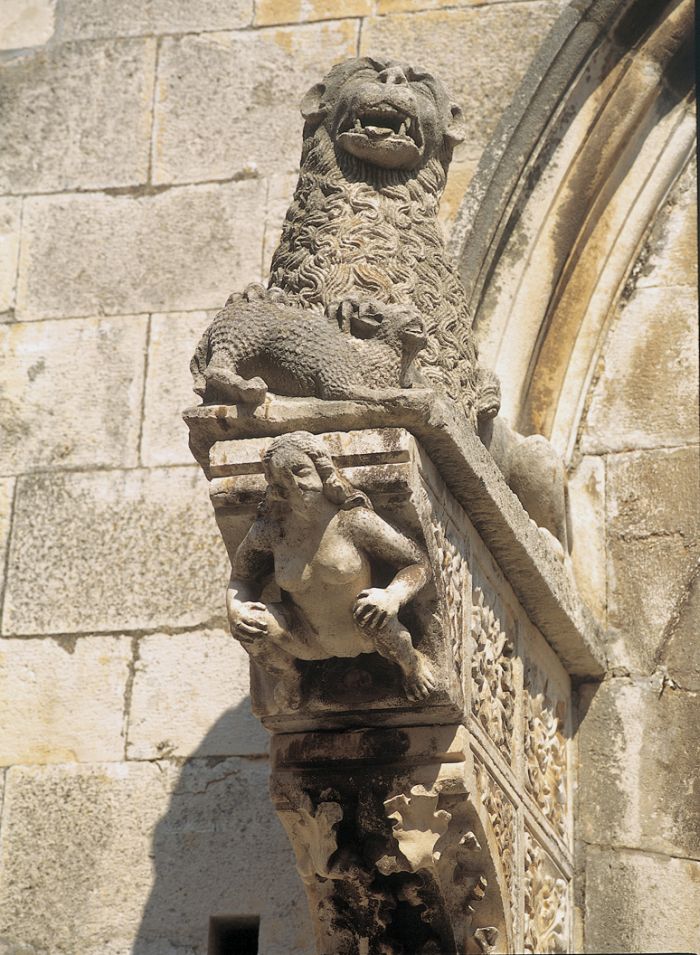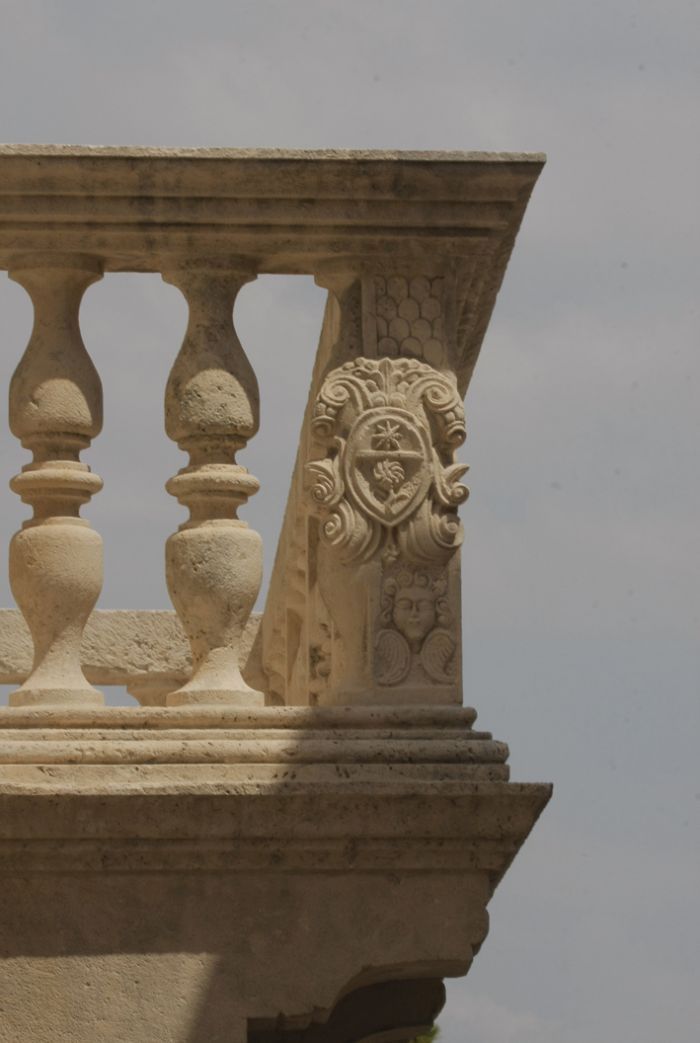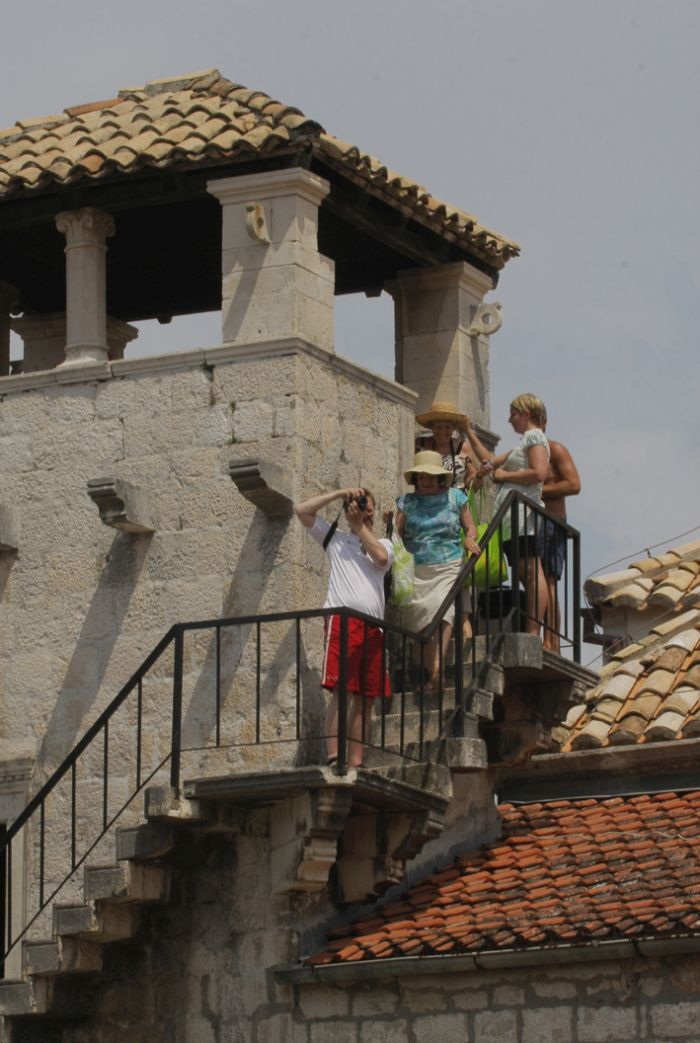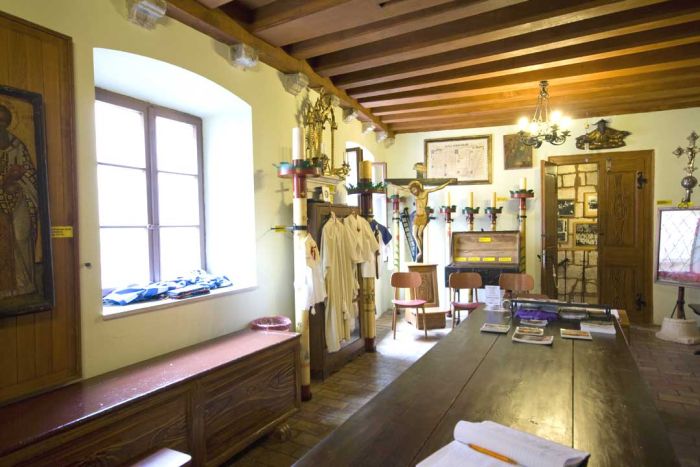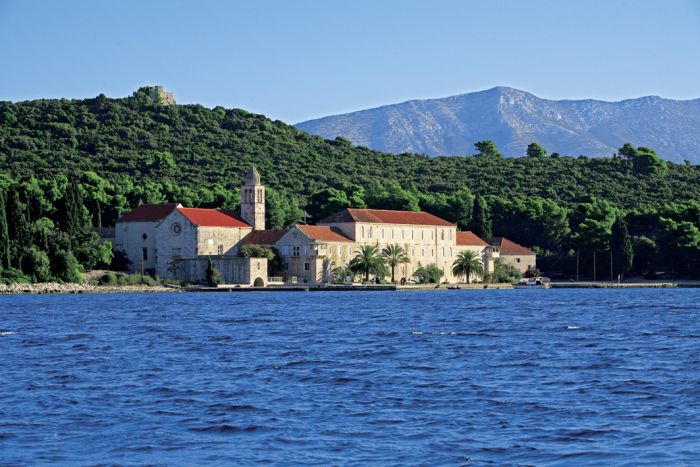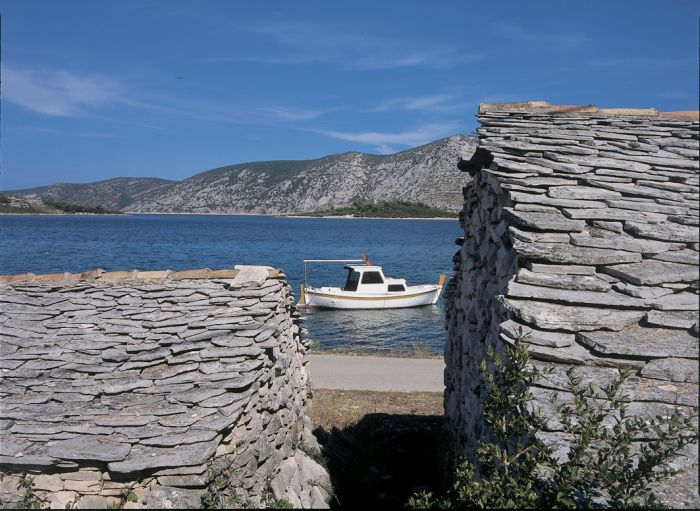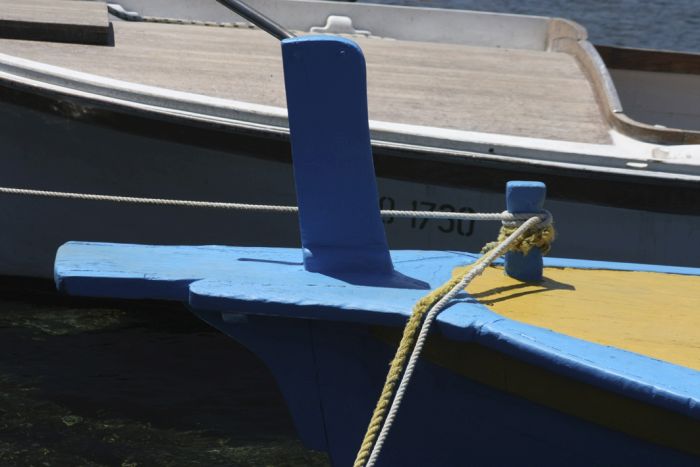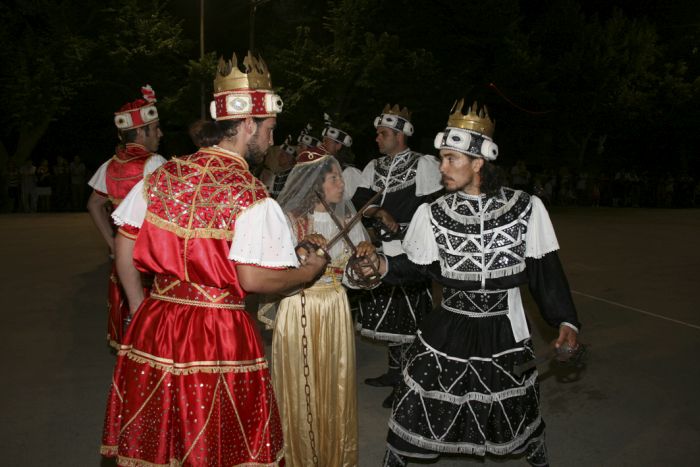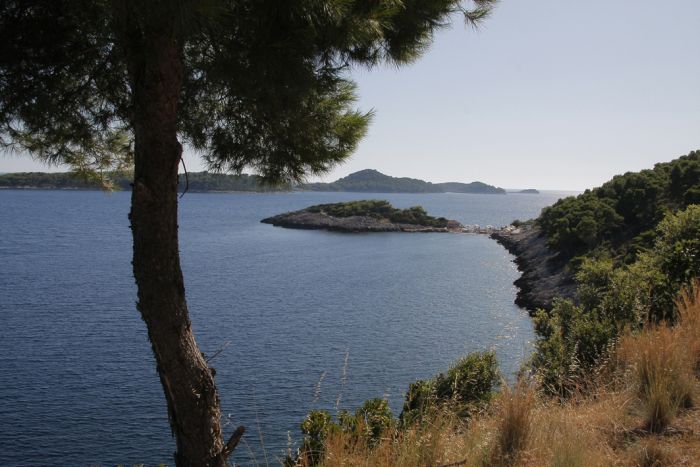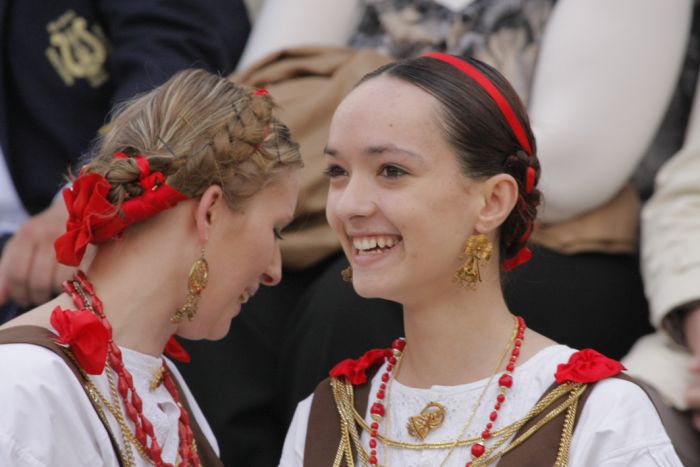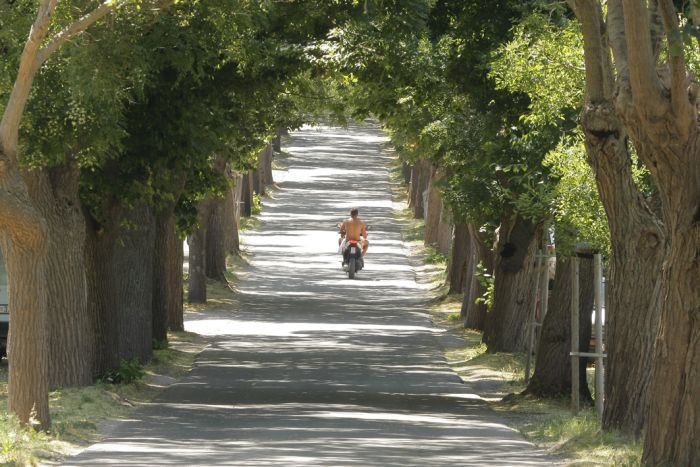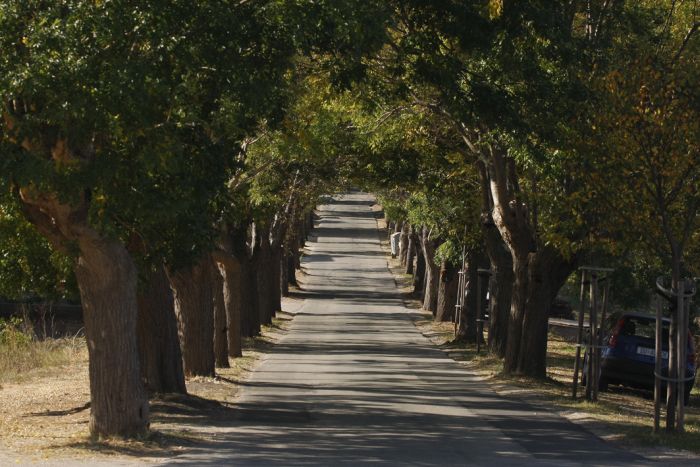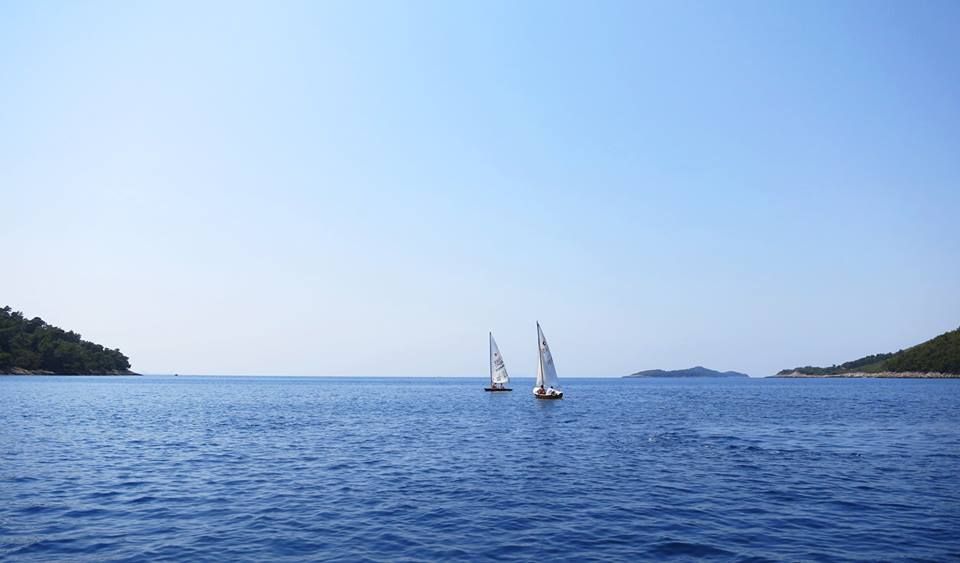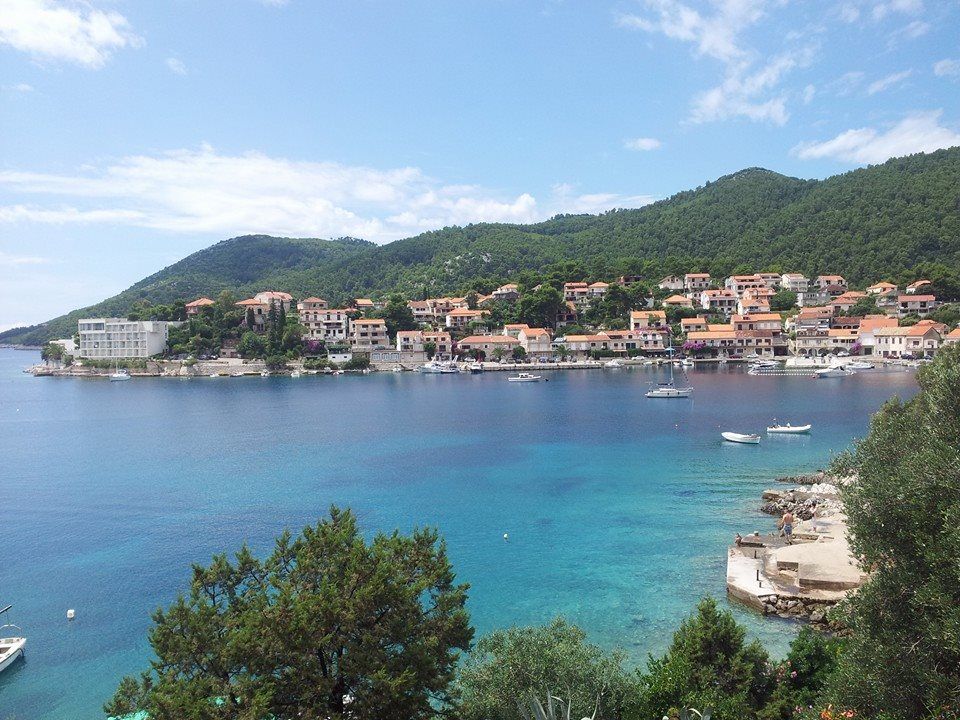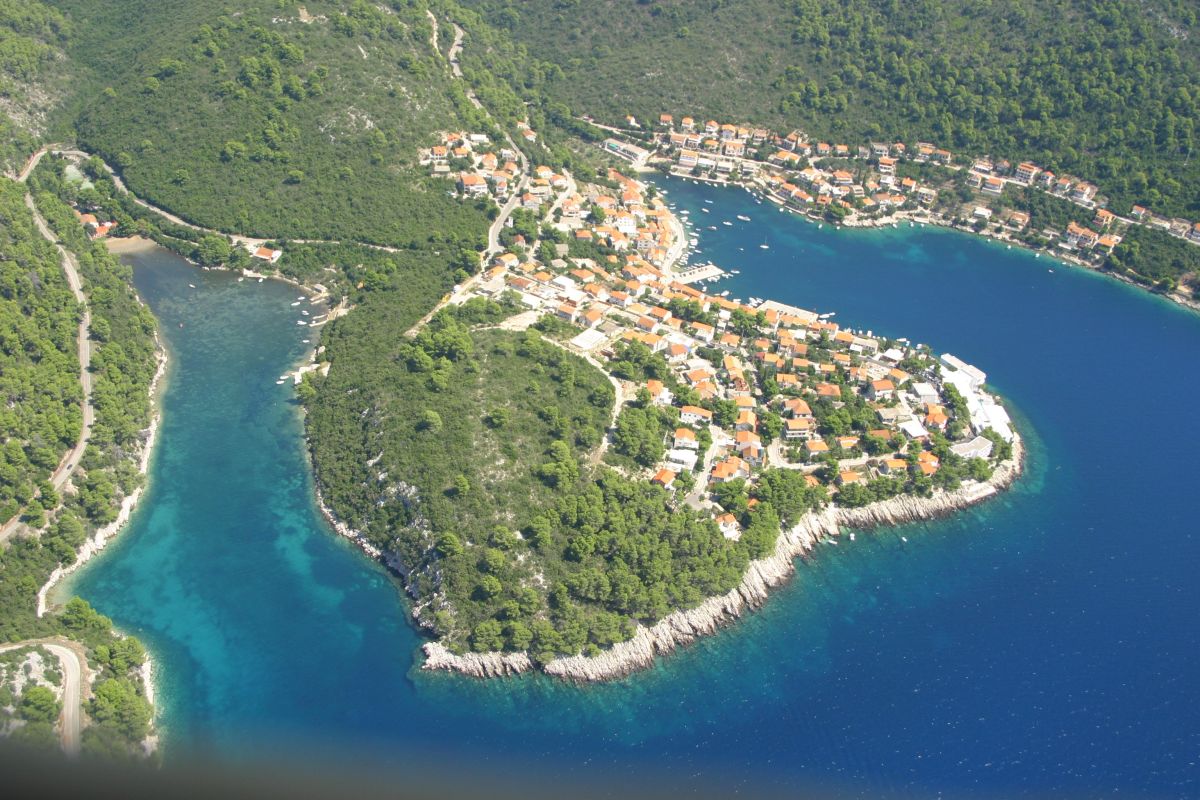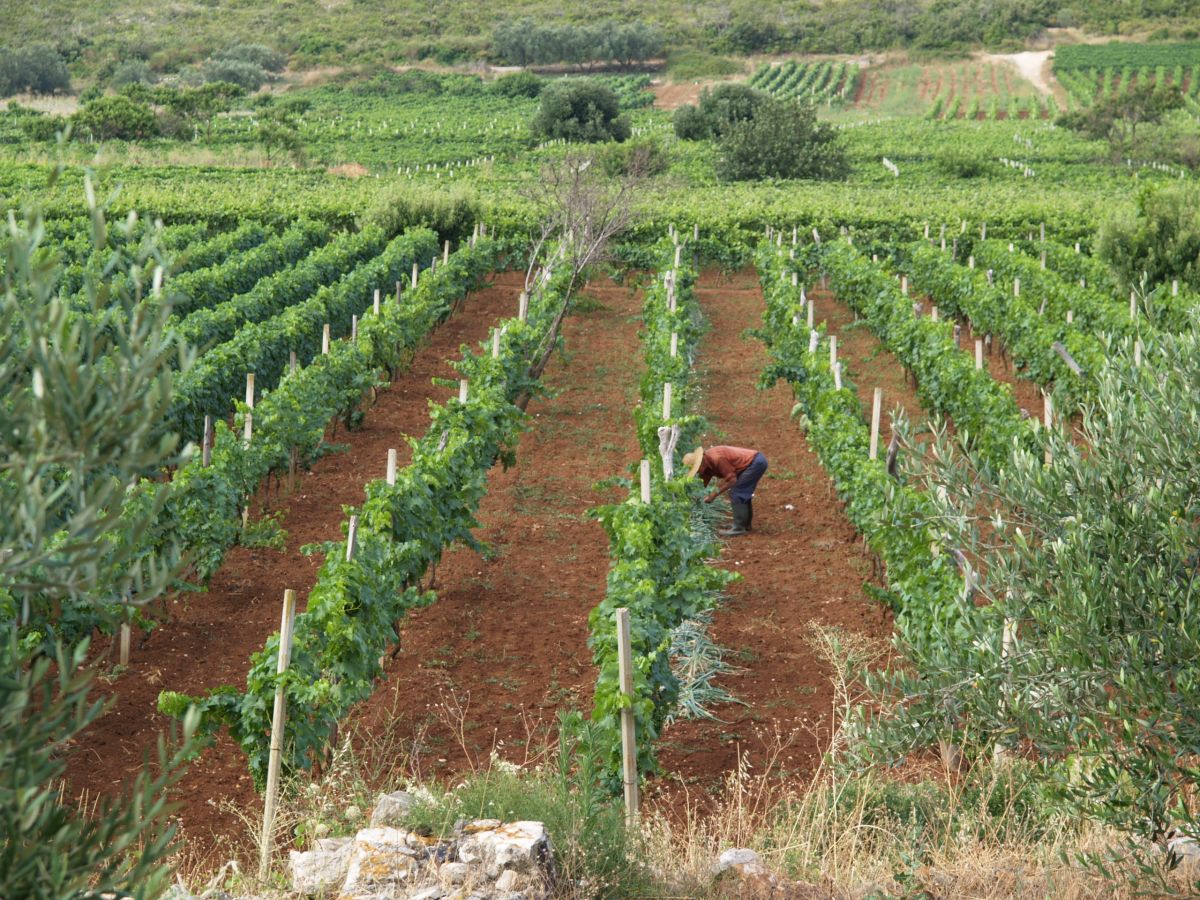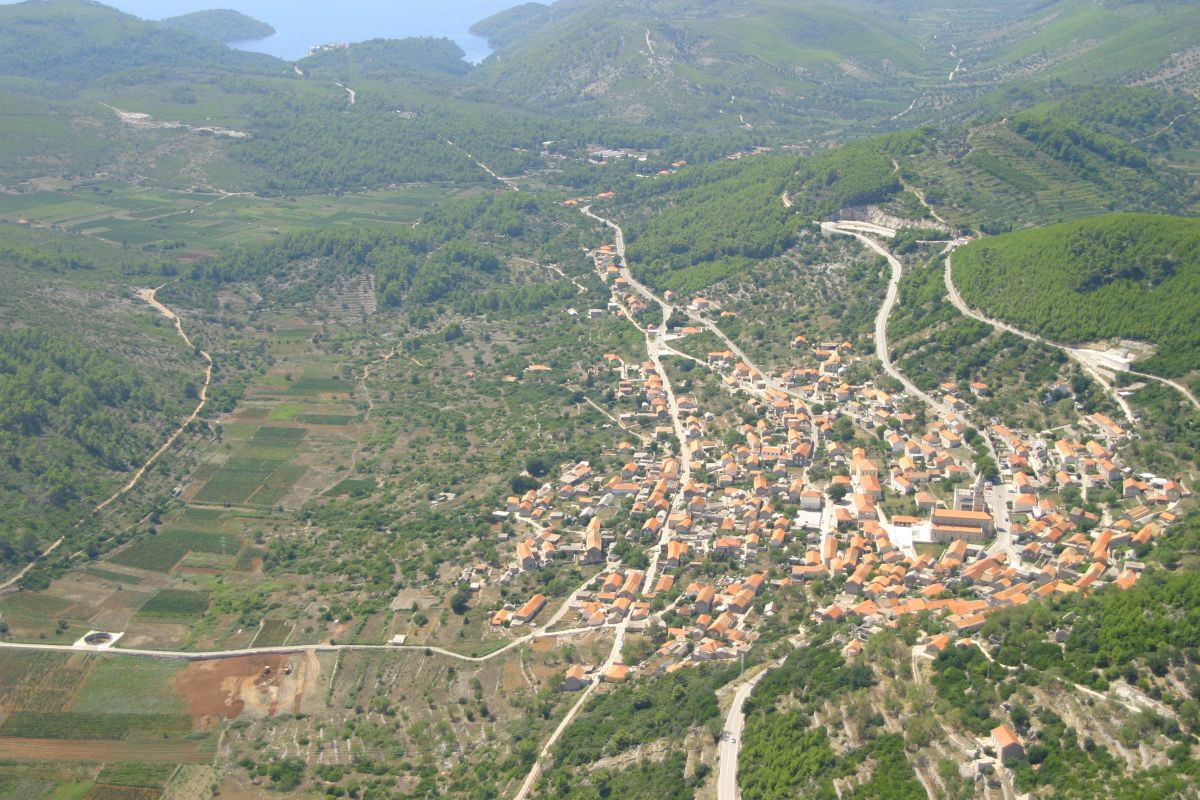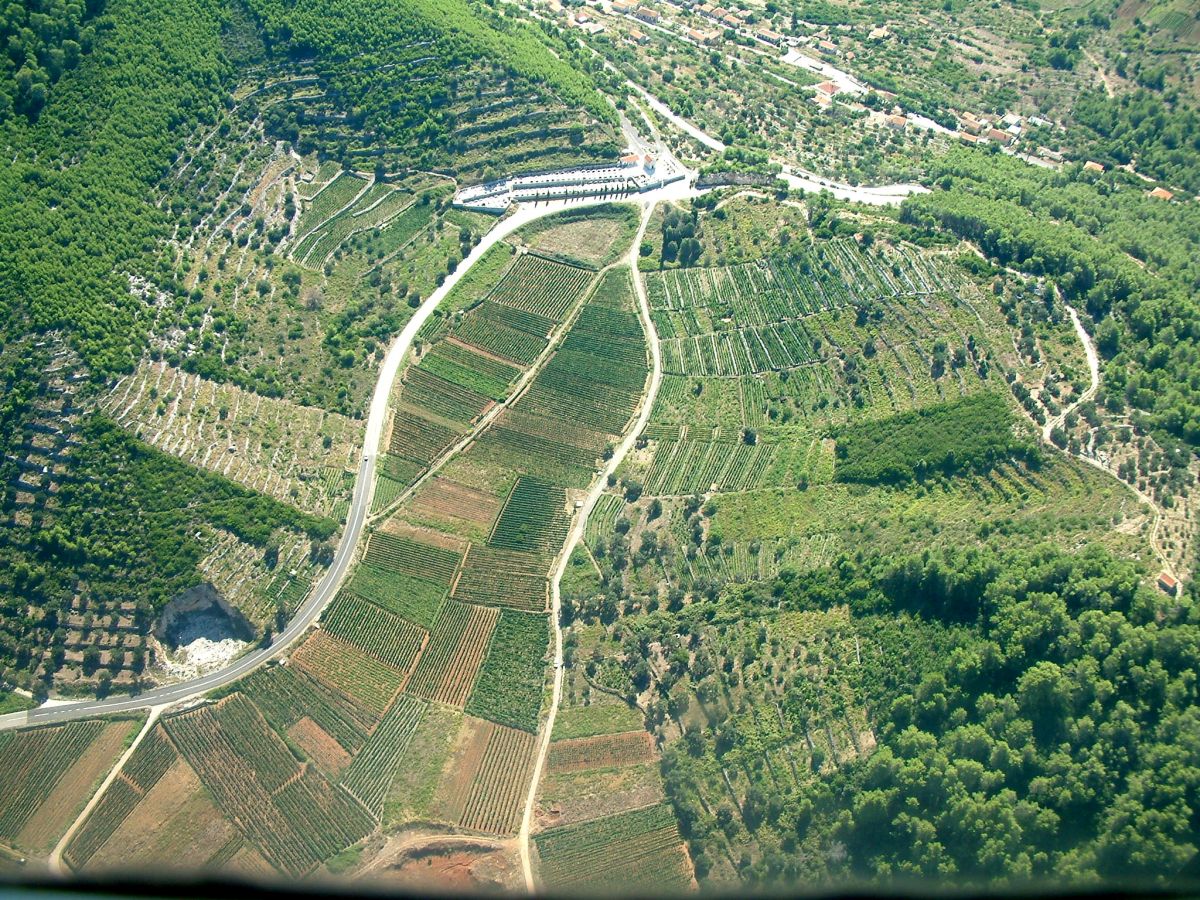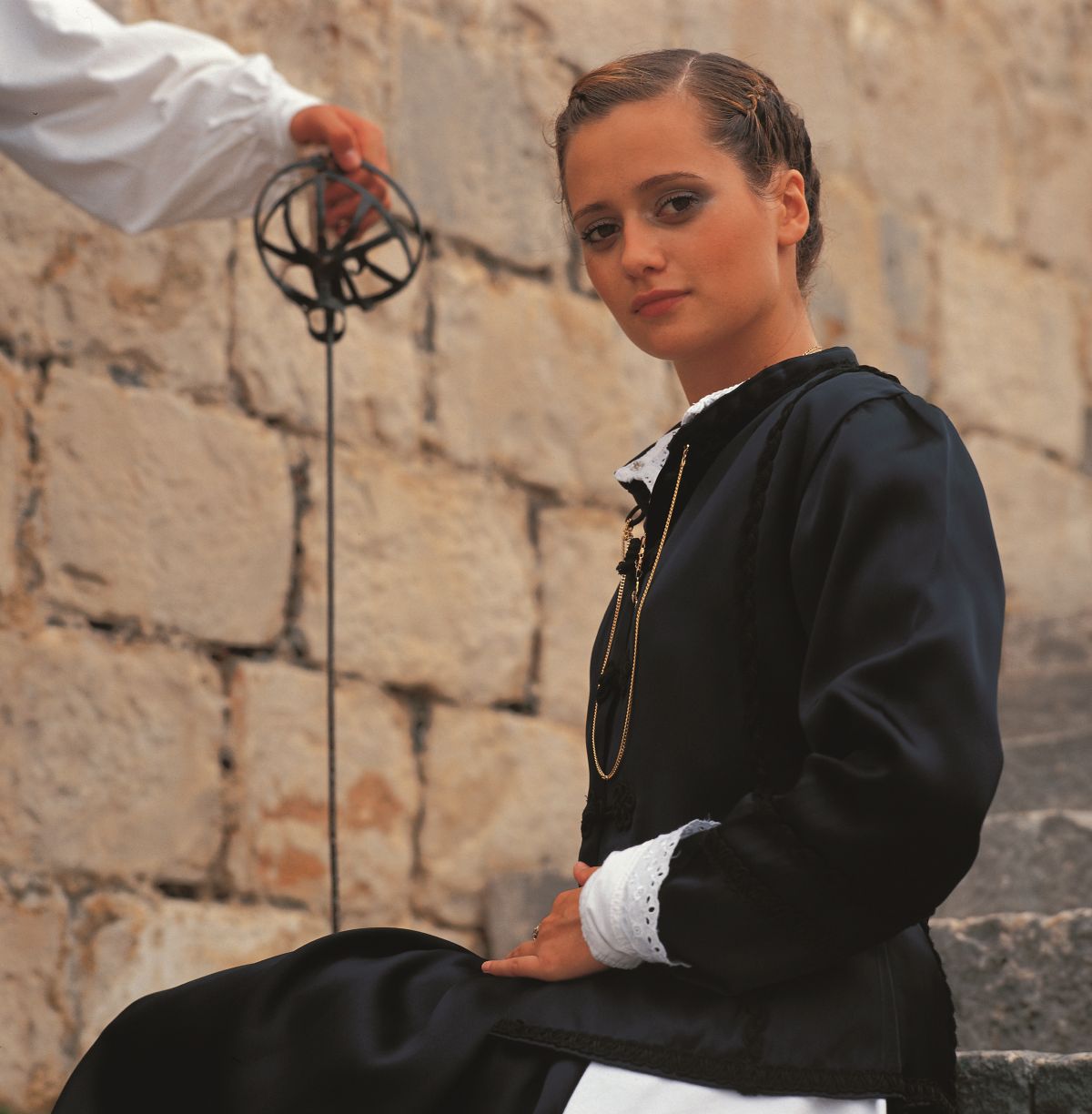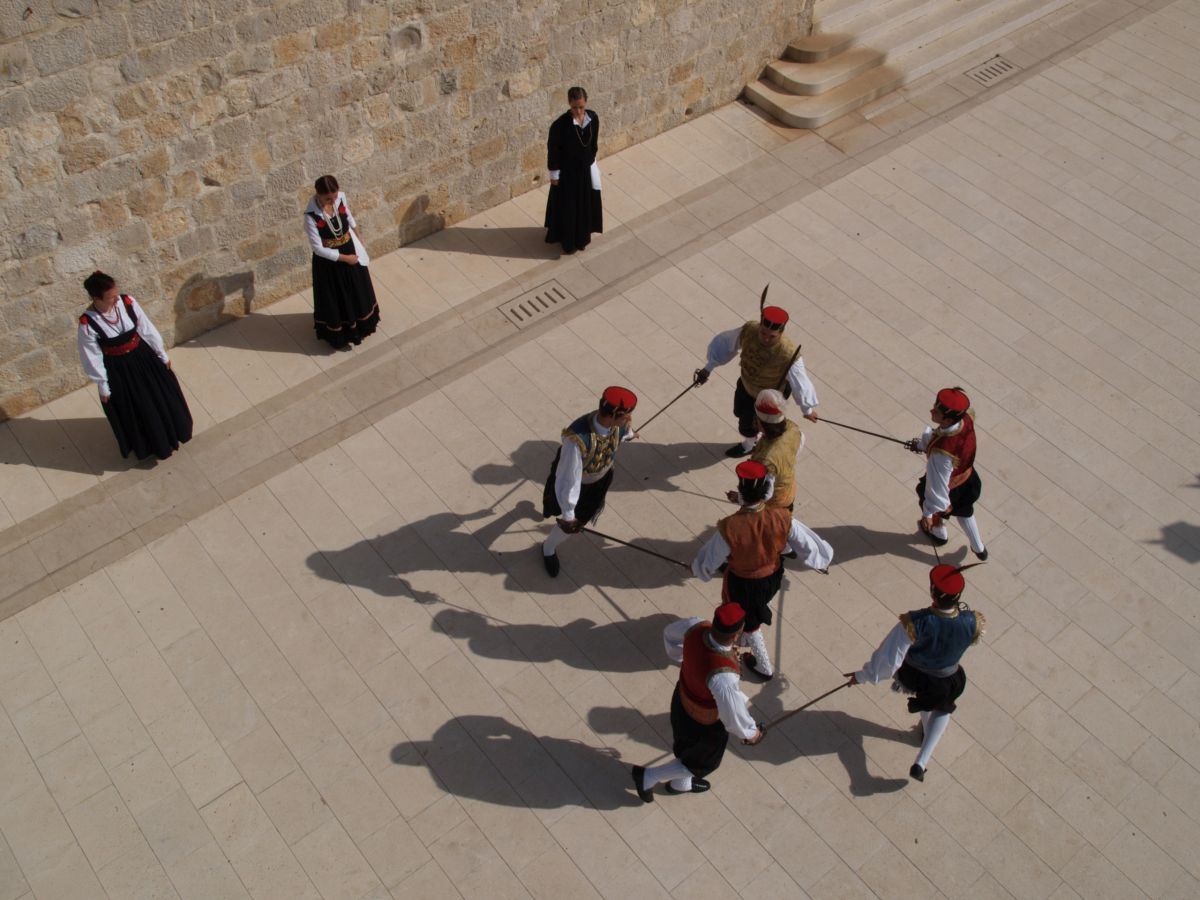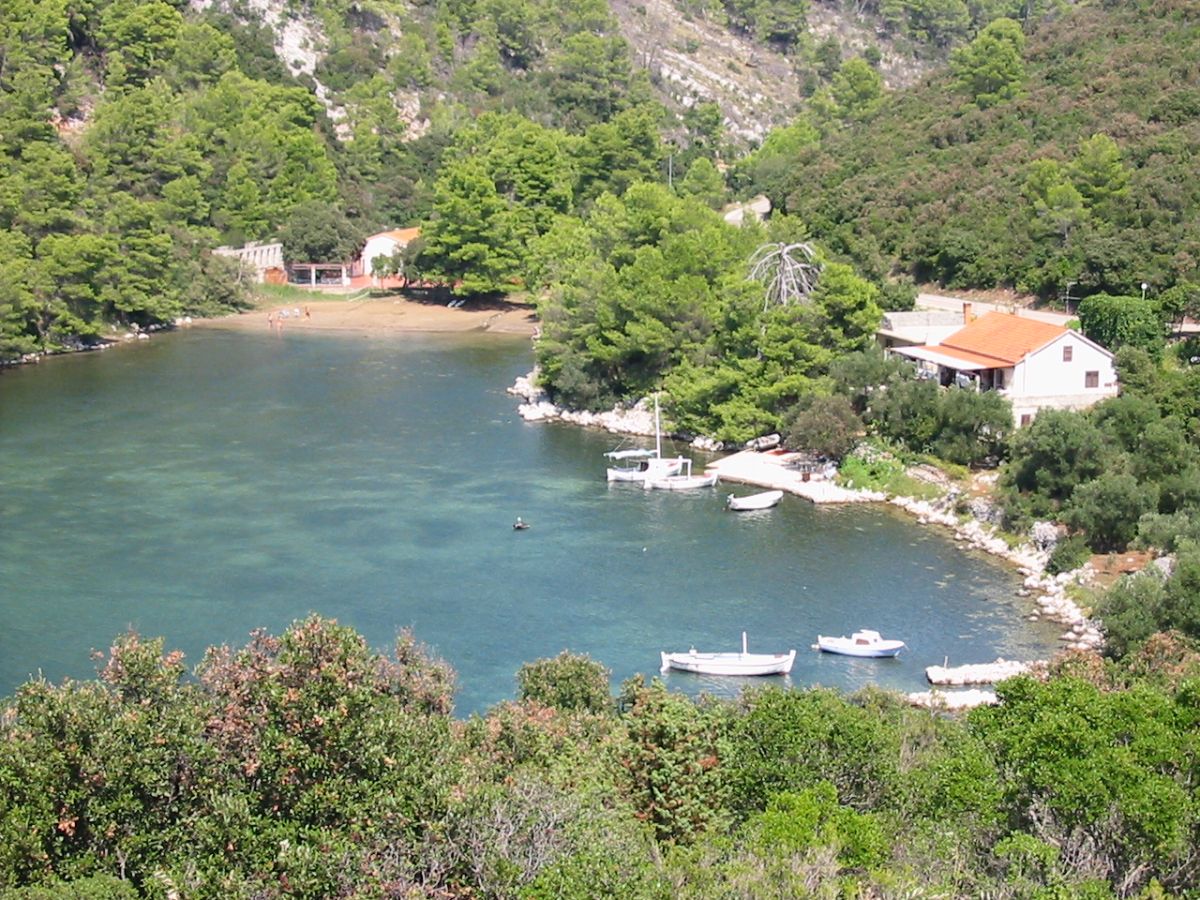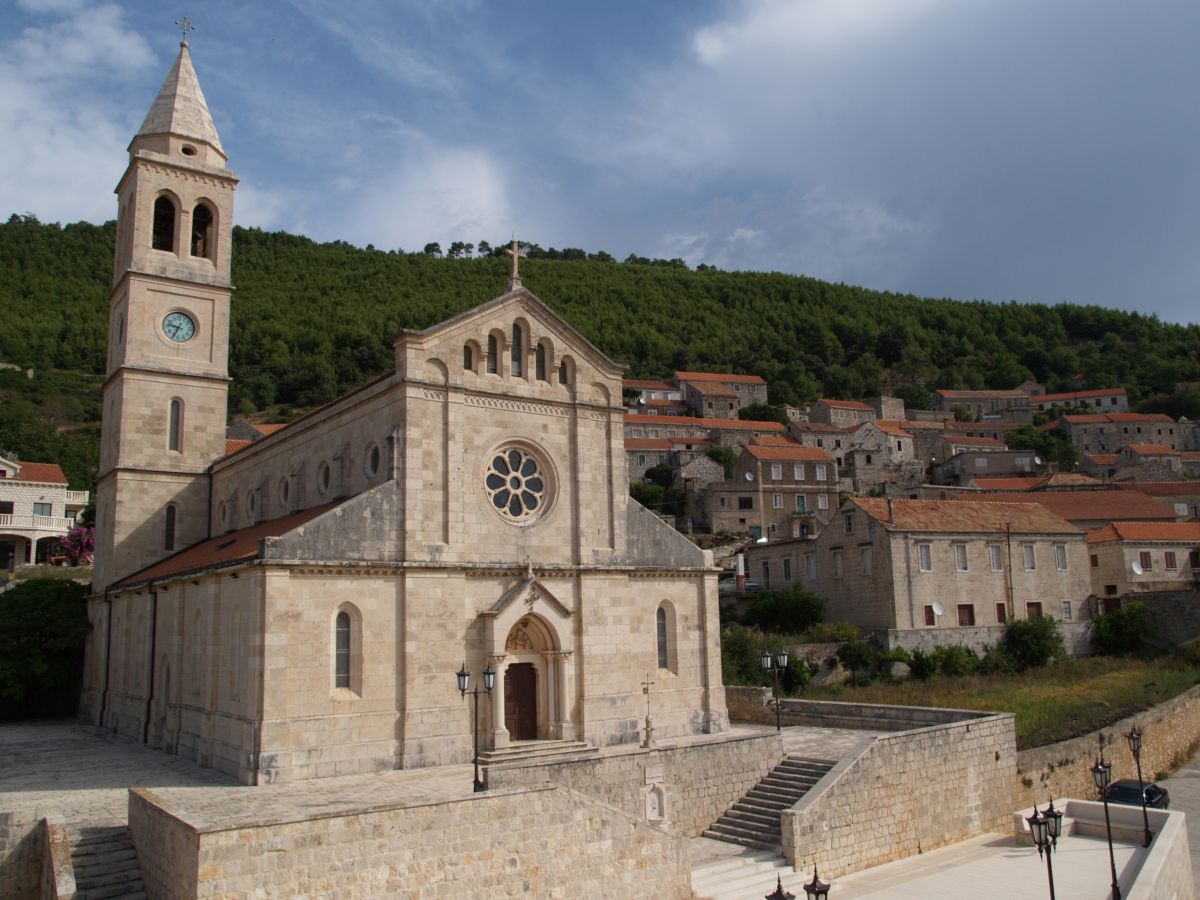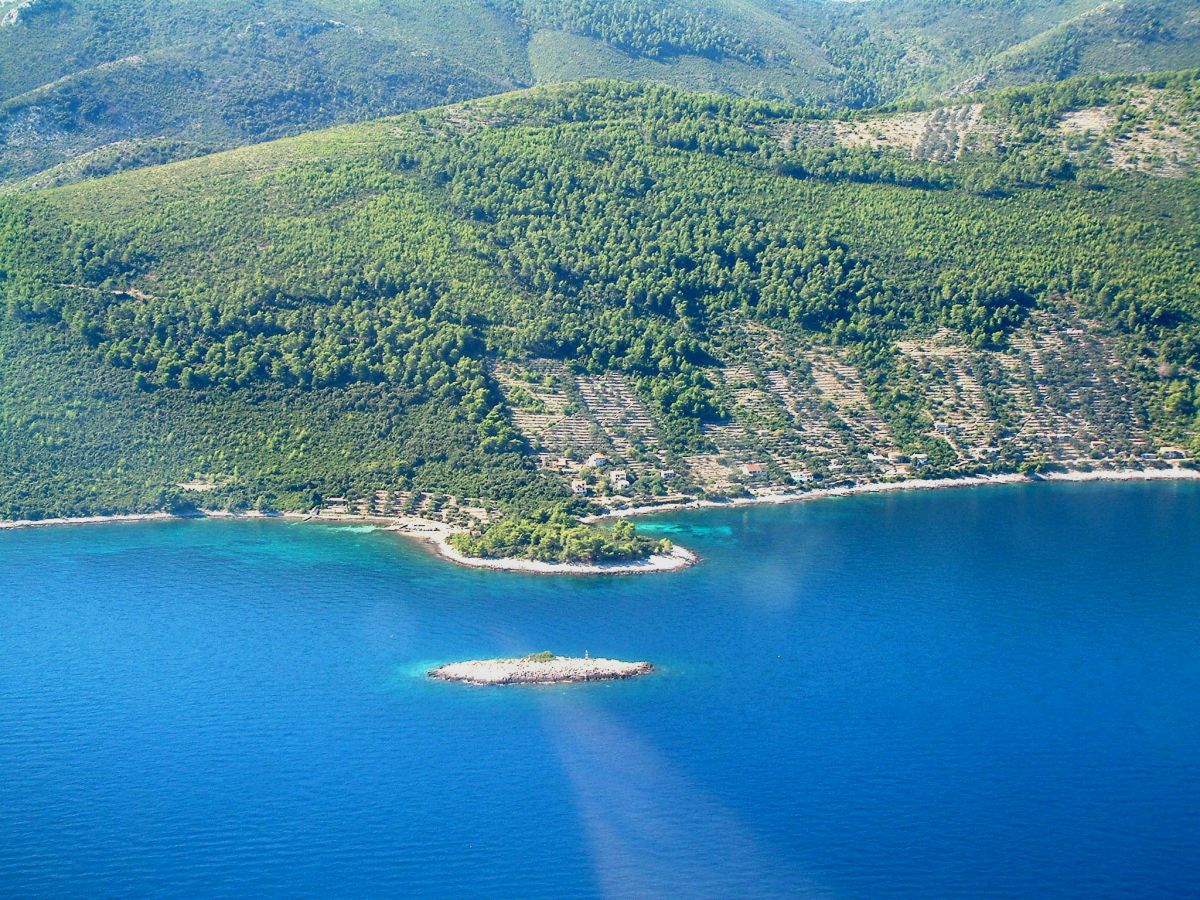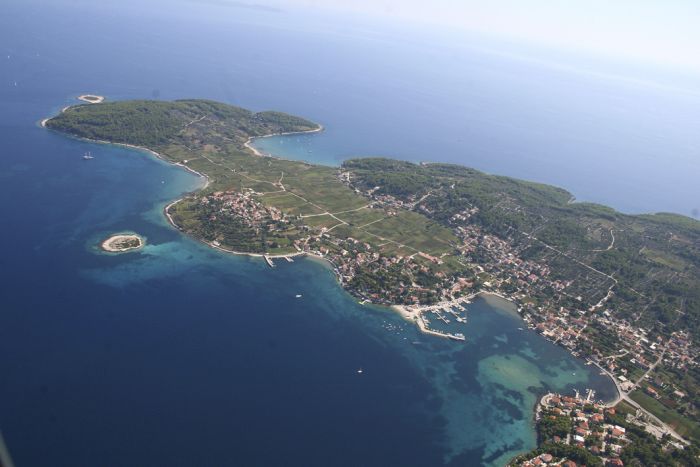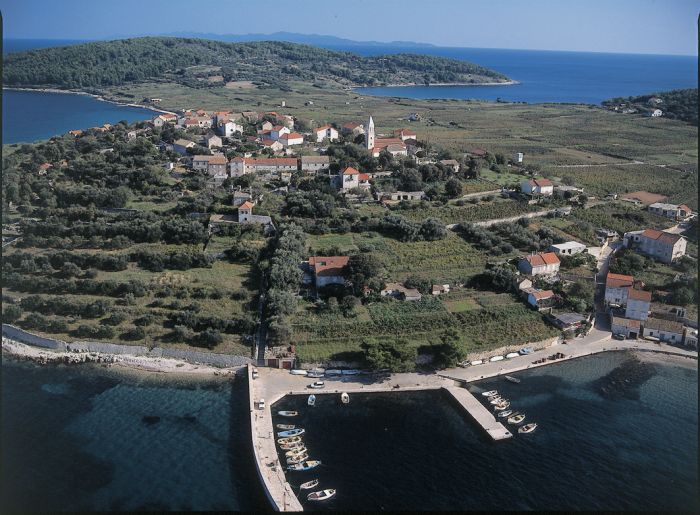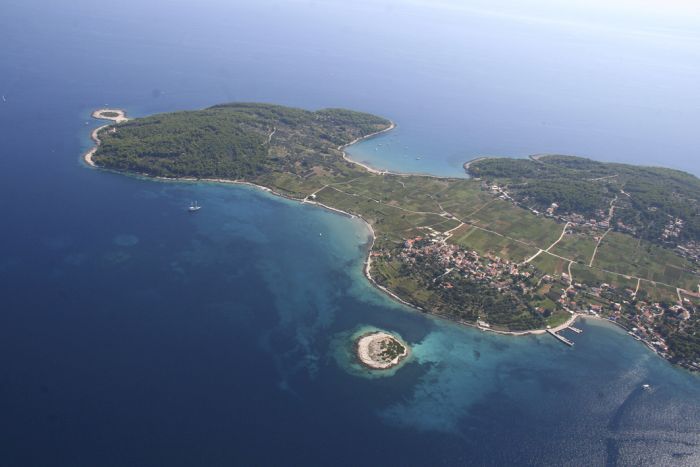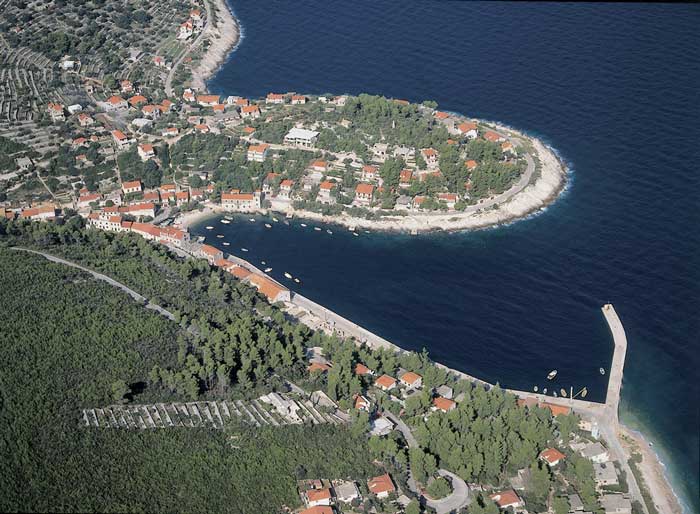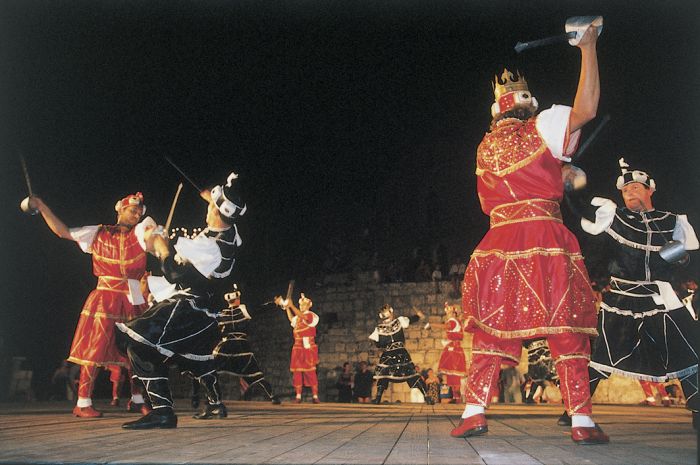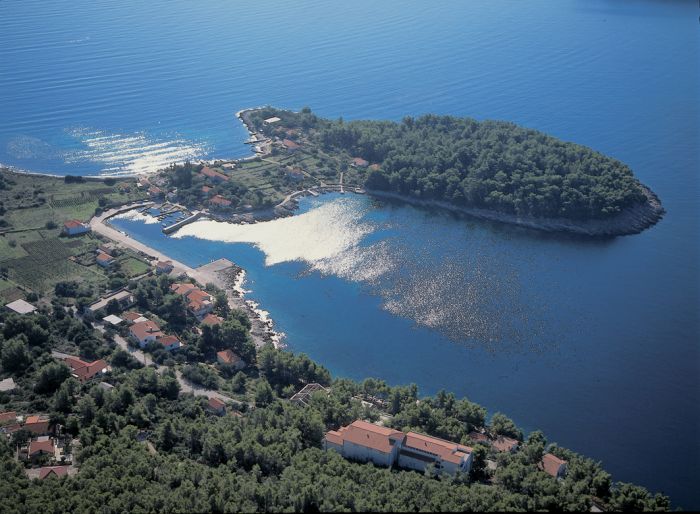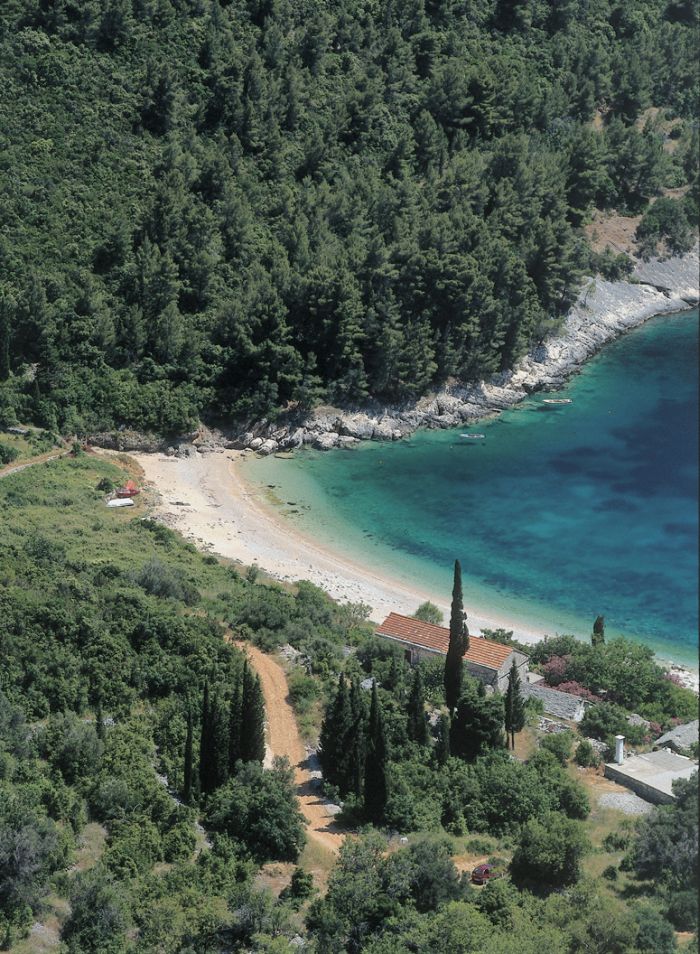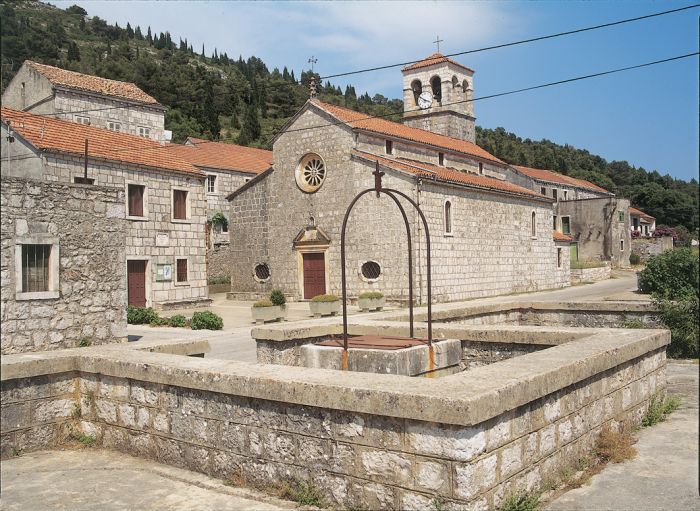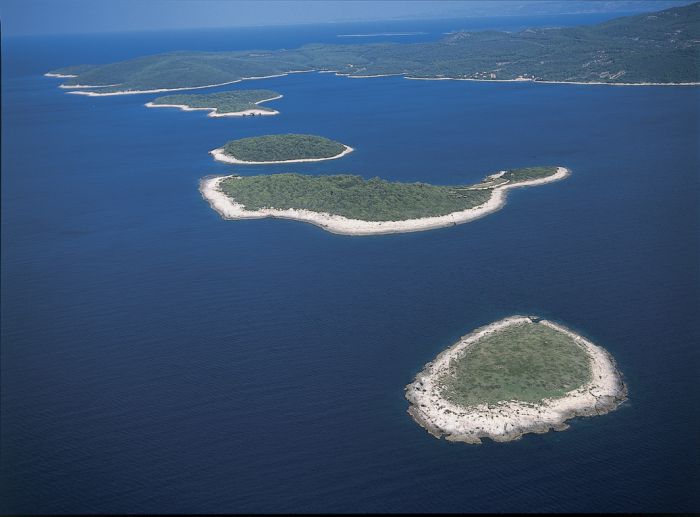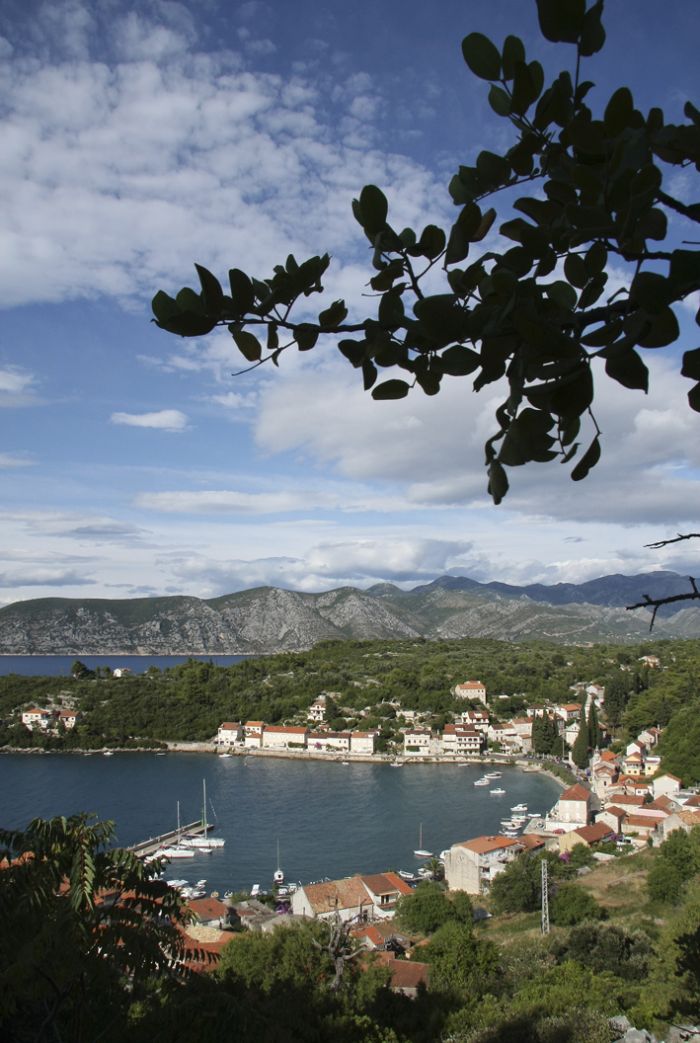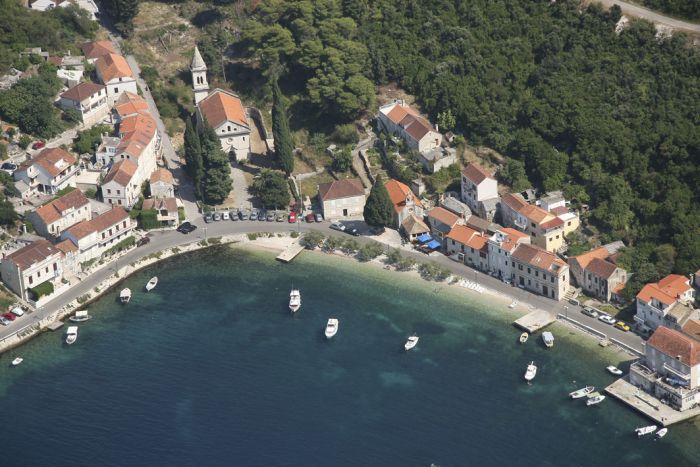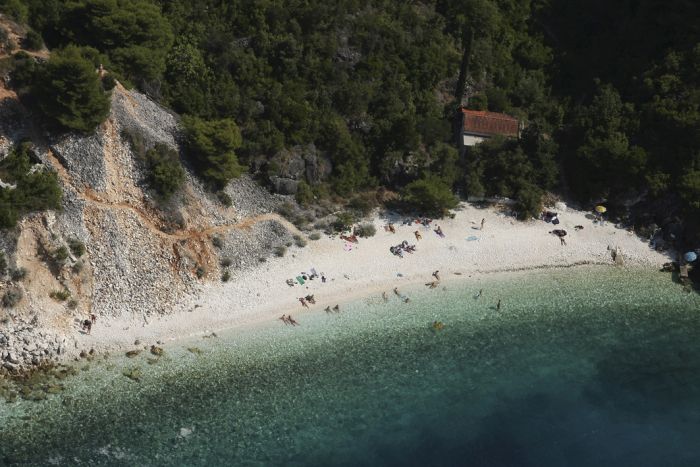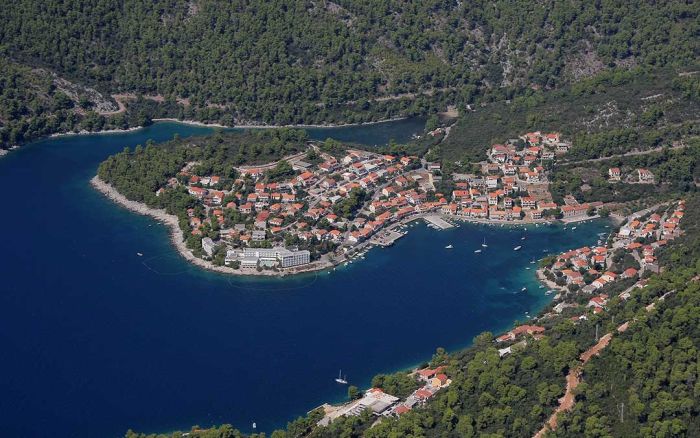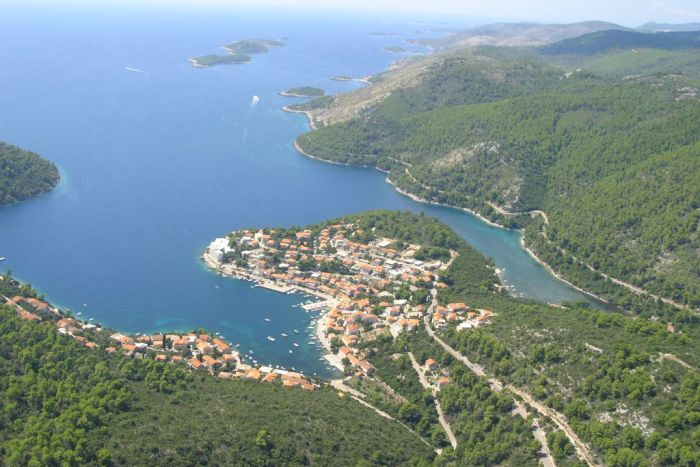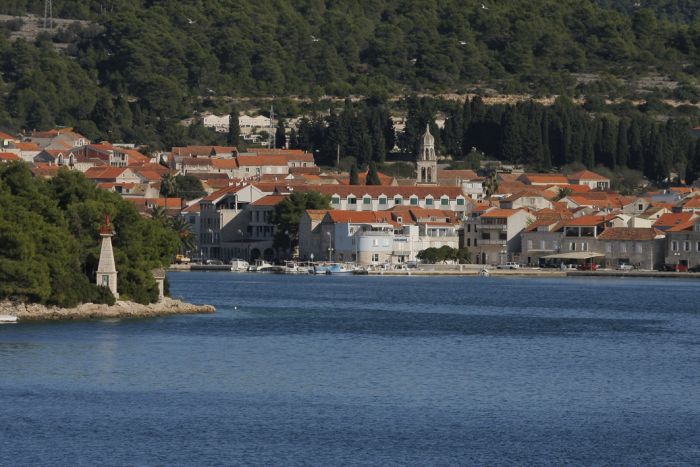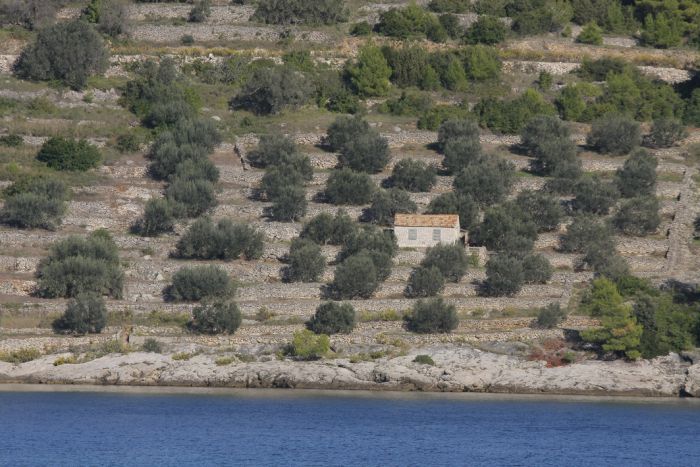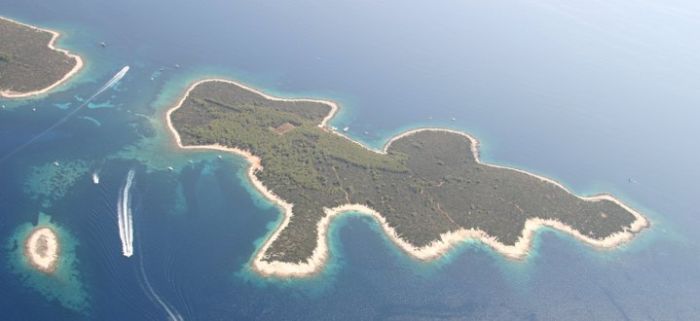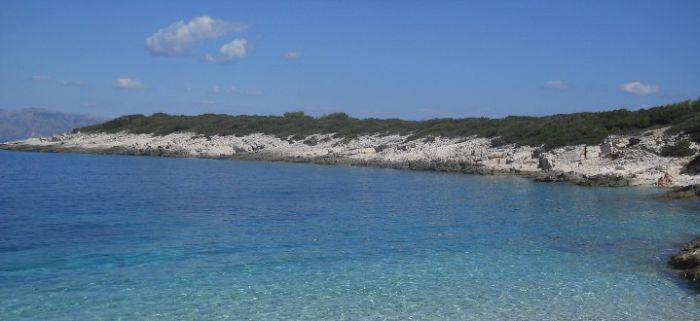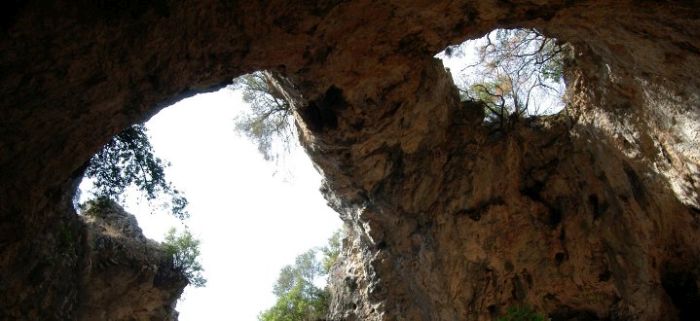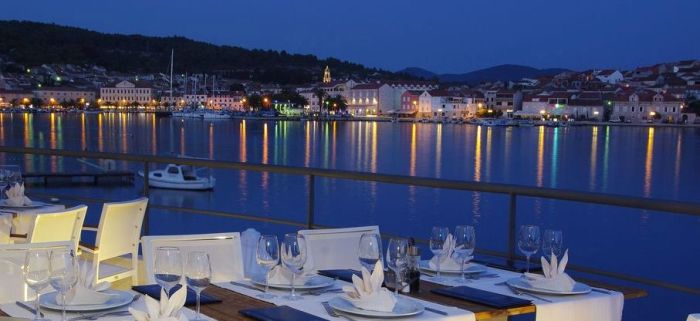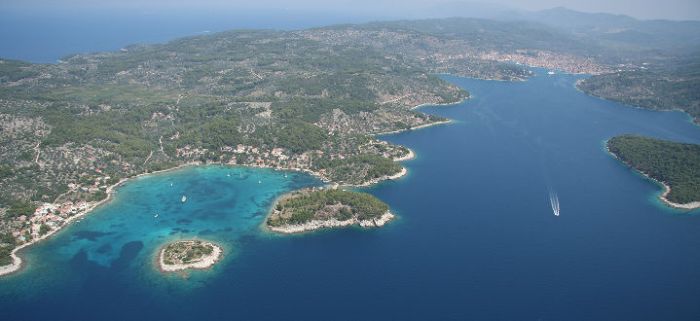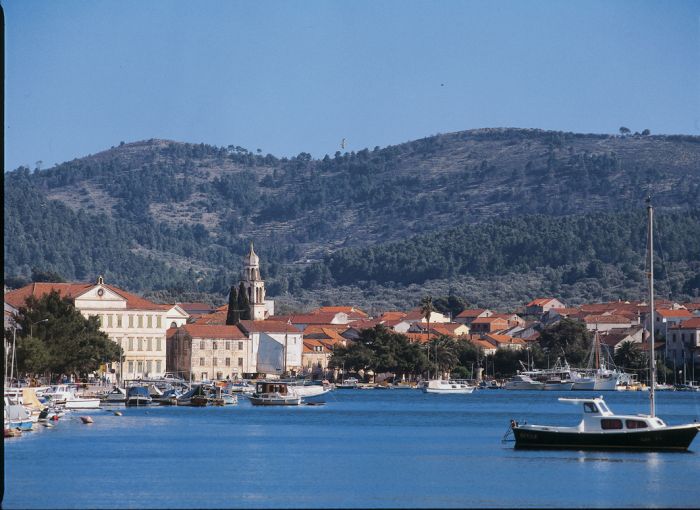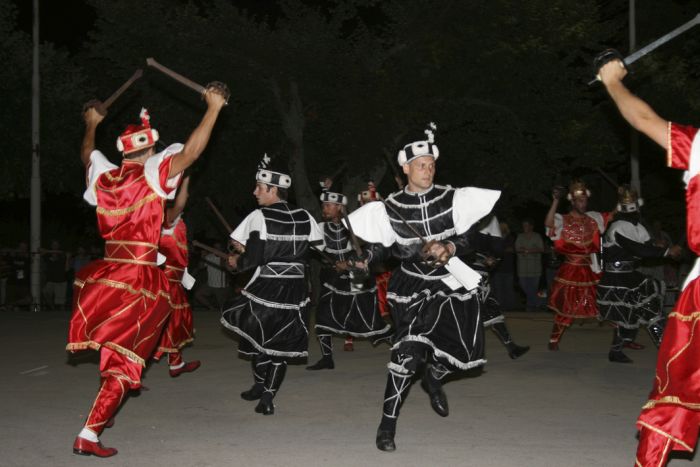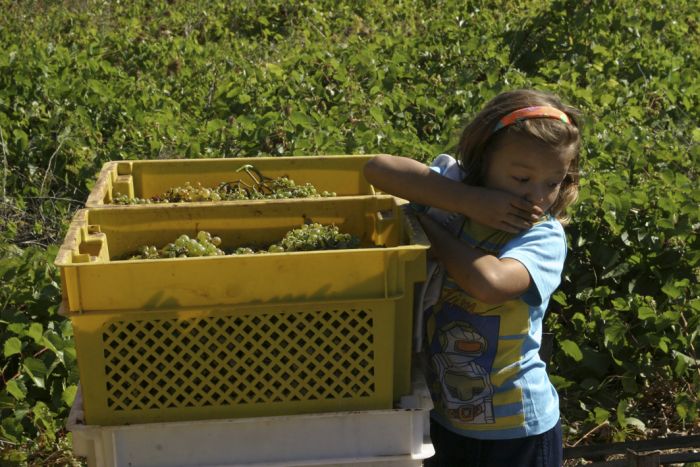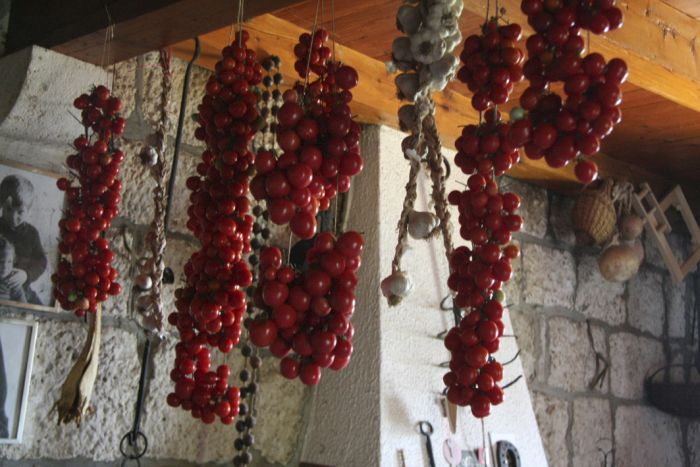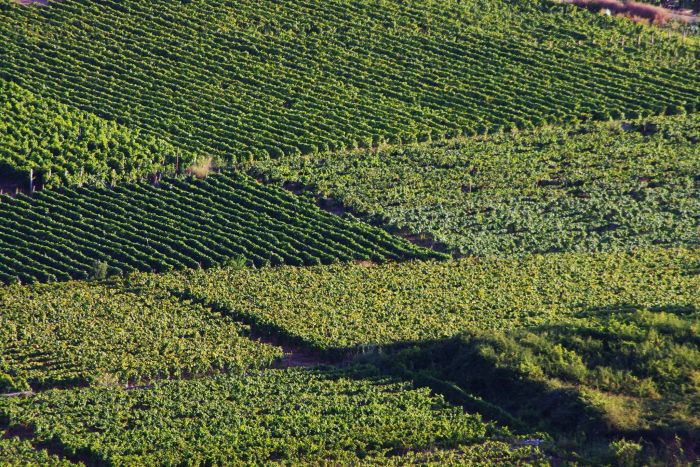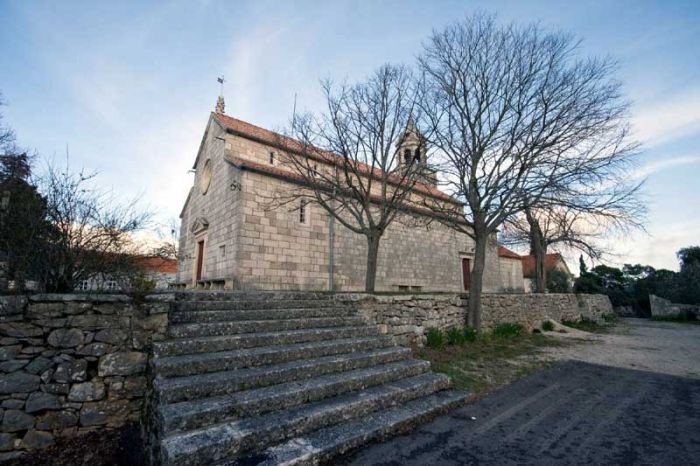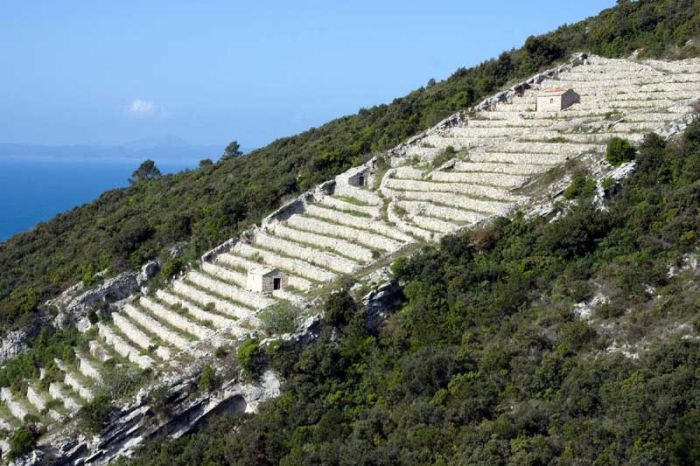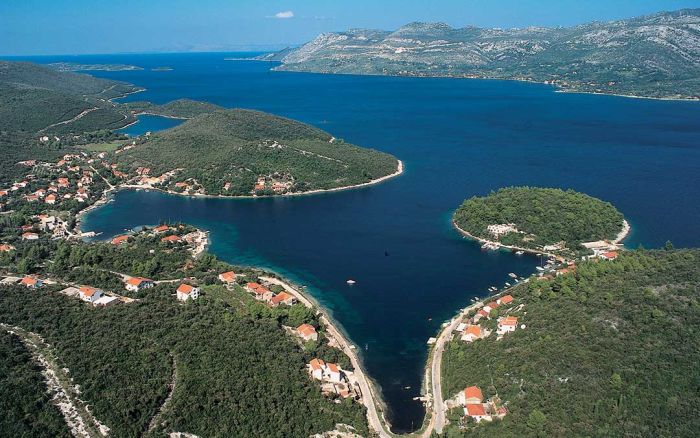Korčula
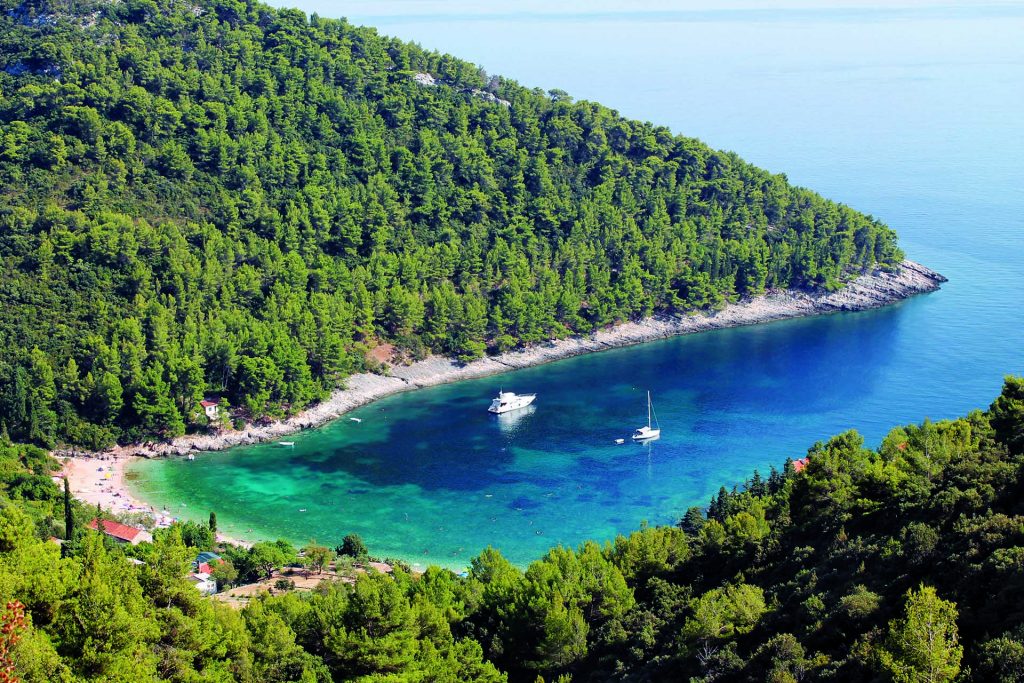 Korčula – this central Dalmatian island stretches out parallel to the nearby mainland in a west-east direction. The island is 46.8 km in length, with an average width of 5.3 to 7.8 kilometres and a surface area of 270 km2, making it the sixth-largest island in the Adriatic Sea. It is separated from the Pelješac peninsula by the Pelješac Channel, only 1270 m wide at its narrowest point. The island of Korčula is indented with a series of bays and coves. The climate on the island is very mild, with a Mediterranean character. The average temperatures are relatively high: the annual temperature is 16.8°C, 9.1°C in the coldest month of January, while the hottest month, July, is 26.9°C. Exploring the island only adds to its natural beauty: every part of it is worth exploring. Near the city of Korčula is an archipelago of twenty uninhabited islands covered in dense macchia thickets and accessible coastline: on some, the smooth stone slabs along the shore are perfect for sunbathing.
Korčula – this central Dalmatian island stretches out parallel to the nearby mainland in a west-east direction. The island is 46.8 km in length, with an average width of 5.3 to 7.8 kilometres and a surface area of 270 km2, making it the sixth-largest island in the Adriatic Sea. It is separated from the Pelješac peninsula by the Pelješac Channel, only 1270 m wide at its narrowest point. The island of Korčula is indented with a series of bays and coves. The climate on the island is very mild, with a Mediterranean character. The average temperatures are relatively high: the annual temperature is 16.8°C, 9.1°C in the coldest month of January, while the hottest month, July, is 26.9°C. Exploring the island only adds to its natural beauty: every part of it is worth exploring. Near the city of Korčula is an archipelago of twenty uninhabited islands covered in dense macchia thickets and accessible coastline: on some, the smooth stone slabs along the shore are perfect for sunbathing.
History of Korčula
The island of Korčula has been inhabited since prehistoric times, with past traces of life being uncovered at many places on the island. The oldest finds were stone knives from the Neolithic age discovered on the islet of Badija near Korčula. The site with the richest Neolithic age finds is Vela spilja (Large Cave) at Vela Luka.
The island was inhabited by the Greeks in the 6th century BC, first at Vela Luka, and it was also colonized by Knids who called the island Korkyra Melaina. Somewhat later on the other side of the island, in the area where Lumbarda is located today, Greeks settled from the island of Vis (Issa), founding a separate settlement. In the 1st century BC, the island, with ther rest of Dalmatia, was conquered by the Romans, who called it Corcyra Nigra. In 7th century A.D., the Slavs-Croats made their way to the Adriatic coast and soon formed their own state, first a principality, but later becoming a kingdom of its own with the crowning of the first Croatian King Tomislav in 925. Korčula was also included within its borders. The Roman population fled from Salona from the Slavs to the islands of Brač, Hvar and Korčula, and after the situation settled, the majority returned to their original places of residence, while the rest assimilated with the settlers.
In the year 1000, the Venetian Doge Petar II Orseolo took over the Dalmatian cities and islands, thus making Korčula falling under Venetian rule. Following this, the rulers of Korčula changed frequently: the Venetians were replaced by the Zahumlje governors, followed by the Austro-Hungarian kings before the Venetians took over again, and from 1413 to 1420 the island was under the Dubrovnik Republic before again falling under Venice in 1420, which lasted until 1792.
When Napoleon brought down the Venetian Republic, Dalmatia was under Austrian rule for a short time before the French arrived. From 1804 to 1805, Korčula was under French, then Russian rule, before the French again took control from 1897 to 1913. The English became rulers of the island in 1815, when the Vienna Congress set out the new borders of Europe.
Dalmatia came under Austrian rule and remained until the end of World War I, but only in 1921 was the newly created Kingdom of Serbs, Croats and Slovenes formed, which later took on the name Yugoslavia. Following the multi-party elections in 1990, the citizens of Croatia decided in a referendum to secede from Yugoslavia, and the independent state of the Republic of Croatia was declared.
Korčula (City)
Korčula is a historically fortified town on the protected east coast of the island of Korčula, with an approximate population of 2900 inhabitants. The old city is surrounded by walls, and the streets are arranged in a herringbone pattern allowing free circulation of air but protecting against strong winds. The town’s historic sites include the central Gothic and Renaissance Cathedral of St Mark, the Town Hall and the massive city fortifications. The 15th-century Franciscan monastery with a beautiful cloister is situated on the islet of Badija, near Korčula Town.
Informacije
Korčula Tourist Board
Trg 19. travnja 1921., 40
20260 Korčula
info@visitkorcula.eu
www.visitkorcula.eu
Tel: +385 (0) 20 715701
Badija
Badija is an islet in the eastern part of the Pelješac Channel with a surface of approx. 1 km2. The Ježevica Channel separates it from the island of Korčula. The average yearly temperature is 13°C. Along the coast, there are good anchoring sites for mid-sized vessels, while small boats can be moored west of the monastery.
Almost the entire surface of Badija is covered in macchia thickets and pine woods, with the highest point on the island being only 74m. The monastery and single nave church there today were erected in the late Gothic style, after 1420. In 2003 the monastery was returned into the ownership of the Franciscans and can today be visited upon request. For more information please visit (www.badija.com). The Chapel of St. Catherine (Sv. Katarina), dating back to the 15th and 16th centuries and situated on the hill behind the monastery. Badija and all of its surrounding natural beauty can be explored with a leisurely stroll along the gravel pathway, which covers the entire islet.
Information
Korčula Tourist Board
Trg 19. travnja 1921., 40
20260 Korčula
info@visitkorcula.eu
www.visitkorcula.eu
Tel: +385 (0) 20 715701
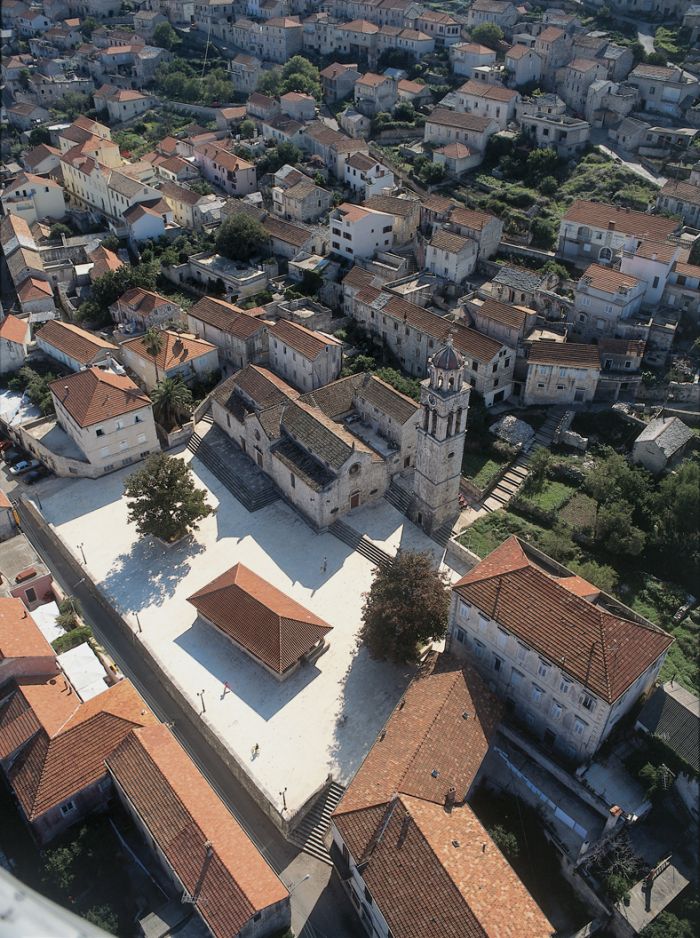 Blato
Blato
The municipality of Blato has about 4000 residents, while the town itself can be reached via the main island road from Smokvica. It passes through the forested sections of the centre of Korčula. The town was built in the form of an amphitheatre on several hills surrounding a small central valley. A long alley of linden trees called Zlinja stretches through the valley, and in recent times, all the public buildings have been constructed here: the school, hotel, banks, shops, the municipal buildings, health clinics and others.
In the old centre south of Zlinja, the triple nave parish Church of All Saints is located on the large tiled square. This church, first mentioned in the early middle ages, was repurposed and adapted several times, with its bell tower design dating to the Baroque period somewhere between the 17th and 18th century. The main altar bears a painting by the Venetian master Girolama Da Santa Croce: the All Saints from 1540. The Chapel of St. Vincenza the martyr, with its richly ornamented marble altar, holy water basin and liturgical silver ornaments was added to the southern nave in the 18th century.
The feast of this saint is celebrated on 28 April, which is also when the municipality of Blato celebrates its day. A great procession passes through the entire town, and a ceremonial gathering (Kumpanija) is held on the main square before the church. The building next to the church contains a valuable collection of art, precious documents and archaeological finds tied to the history of Blato.
There are a great number of small churches and chapels in the town and the surrounding settlements. The oldest is St. Kuzma and Damjan from the 6th century, followed by St. Mary of the Fields, St. Martin and others. The Korčula nobility also built their castles and villas here, one example being the Arneri summer residence in the middle of the town, made in the baroque style. The villa has been planned to house a local museum with archaeological, historical and ethnological collections. Today the residents of Blato are more involved in tourism and other economic branches, while there are several small industries: Radež and Triklop.
The Knight’s Association Kumpanija is very active, and the association, along with the fencing association of the same name, nurture the town’s folklore, songs and culture. The cultural-artistic society “Petar Mila”t also helps keep the musical and folklore traditions alive.
The paved road towards the north coast passes by both the old and new graveyard and takes you to the Prigradica harbour, where there is a hotel, several summer residences and small bed and breakfasts along the seashore, with beautiful beaches nearby. Blato is the hometown to a number of modern Croatian artists, cultural participants, scientists, musicians and more. Mary of the Risen Christ Petković, a servant of God, was born in Blato in 1892. On 6 June 2003, Pope John Paul II beatified her at a ceremony in Dubrovnik.
Information
Blato Tourist Board
Trg dr. F. Tuđmana 4
20271 Blato
tzo-blato@du.t-com.hr
www.tzo-blato.hr
Tel: +385 (0) 20 851850
Fax: +385 (0) 20 851241
Brna
Brna, a bay, harbour and village of the same name on the south coast of the island of Korčula, 4 km southwest of the town of Smokvica and its port. The bay is divided into two parts by the Mali Zaglav peninsula; part of the village and the harbour are situated in the eastern part of the bay.
The coastline is steep from the village of Prižba in the west to the village of Zavalatica in the east. The smaller coves are partially sandy, and are heavily vegetated with bushes and pines. There is a series of small islets off the coast between Brna and Prižba: Vrhovnjak, Crklica, Stupa, Otočac and Sridnjak.
In the 19th century, Brna developed as a port for the export of wine from Smokvica to harbours in the Adriatic and the Mediterranean. In recent years, it has turned to tourism. With good prospects for relaxation and accommodation, tourists can enjoy seafood delicacies in the taverns with excellent white wines (Pošip and Rukatac) from Smokvica. Istruga Bay, near Brna, is filled with medicinal mud, which is frequently used by the locals despite there still being no organized therapy available.
Information
Smokvica Tourist Board
Brna bb, 20272 Smokvica
tzo-smokvica@du.t-com.hr
www.brna.hr
Tel: +385 (0) 20 832255
Fax: +385 (0) 20 832188
Lumbarda
This municipality with over a thousand residents is situated 6 kilometres east of Korčula. It stretches from a shoreline of small coves to the nearby hills, and is surrounded by vast sandy vineyards. A paved road leads to Lumbarda, passing through a picturesque landscape of pine woods and olive groves. This is the site of Greek (Hellenistic) agricultural settlement from the 3rd century BC from which the Psefizma and Gnathia grave vases (now on display in the town museum) originated.
Since the 16th century, the wealthy Korčula landowners and noblemen built their fortified summer villas (Kaštele) at selected locations in Lumbarda. Some are still preserved and inhabited today, including the Nobilo, Milina and Kršinić villas. On the hills around the old part of the town, Vela glavica, we have the triple nave Church of St Rok, the patron saint of Lumbarda. There are also several smaller older chapels in the town: St. Bartholomew (Bartul), St. Peter and Paul, St. Barbara and the Chapel of the Nativity. Surrounded by vineyards, the Chapel of the Holy Cross from 1774 and its characteristic cloisters stand out in particular.
For centuries, the people of Lumbarda have lived off the land, primarily the vineyards. They have fished and worked in the stone quarries and worked as stone masons. Several distinguished Croatian artists, sculptors and painters were born here: Ivo Lozica (1910-1943), Lujo Lozica (1945), Stipe Nobilo (1945), and the most significant among them being Frano Kršinić (1897-1981). His piece, a bronze monument honoring the fallen in World War II, stands in the town centre while his bronze relief, “Fishermen”, is on the hotel building. Not far is the home-studio and collection of local sculptor, amateur and farmer Ivan Jurjević-Knez (1920) and his works in stone and wood.
Today, the locals work in tourism as well as agriculture. In addition to the hotels, there are several campgrounds and many private bed and breakfasts, hospitality facilities, shops and a small marina. The cultural-artistic society “Ivo Lozica” is centered in Lumbarda, and nurtures music, singing, folklore and dramatic amateurism.
Information
Lumbarda Tourist Board
Prvi žal bb, 20263 Lumbarda
info@visitlumbarda.eu
www.visitlumbarda.eu
Tel/Fax +385 (0) 20 712005
Prigradica
Prigradica is a town on the northern coast of the island of Korčula, near Blato. Once a well known export harbour for the highly esteemed Blato wine and olive oil, today Prigradica is a tourist town which has preserved its authentic rustical appeal. The nearby villages, untouched for centuries, present a unique way to experience the past.
Information
Blato Tourist Board
Trg dr. F. Tuđmana 4
20271 Blato
tzo-blato@du.t-com.hr
www.tzo-blato.hr
Tel: +385 (0) 20 851850
Fax: +385 (0) 20 851241
Prižba
This stunning bay on the south side of the island of Korčula is one of the loveliest on the island. Its surroundings are embellished with vineyards and luxurious villas, coniferous forest and rocky cliffs.
Information
Blato Tourist Board
Trg dr. F. Tuđmana 4
20271 Blato
tzo-blato@du.t-com.hr
www.tzo-blato.hr
Tel: +385 (0) 20 851850
Fax: +385 (0) 20 851241
Pupnat
This village with 400 residents is situated 11 kilometres from Korčula. The winding road from Žrnovo climbs up the centre of the island to a small valley between the surrounding slopes, where this small and humble village is nestled. Its inhabitants were farmers and livestock breeders, and these today continue to be the main economic activities, though many people work in construction, tourism and other branches. The Church of Our Lady of Snow, renovated and adapted several times, is in the centre of the village. Nearby, at the graveyard, is the Church of St. George (Jurja) from the 15th century, with several dilapidated old chapels in the surrounding areas.
The new island road extends on from Pupnat and climbs quite high, offering a lovely view on a large part of the island’s south coast, especially on the Pupnat harbour with its dense pine woods, while the islands of Lastovo and Mljet can be seen out towards the open sea. Pupnat harbour is connected by a newly cemented road and can be reached by car. The panorama of the south coast is even lovelier if you take the old road, which winds up the slopes, while hikers can walk down the walking trails to the seashore.
Information
Korčula Tourist Board
Trg 19. travnja 1921., 40
20260 Korčula
info@visitkorcula.eu
www.visitkorcula.eu
Tel: +385 (0) 20 715701
Račišće
This village of about 400 residents is accessible by the paved road from Korčula, which stretches along the seashore towards the west, passing by the following bays: Medvidnjak, Žrnovska Banja, Vrbovica and Kneža, where beaches, campgrounds and vacation homes are located. In Kneža, formerly a small fishing village, traces of Roman mosaics have been found, while remnants of Roman structures were found at Banja.
At the end of a 12 kilometre-long road, in a large sheltered bay, lies Račišće, a village founded in the 17th century when refugees, fleeing from the Turks in Herzegovina and the Makarska coastal region arrived. In the past, its inhabitants were primarily fishermen, farmers, livestock breeders and sailors. Today, they are mostly sailors.
The Church of the Mother of God is from 1682, and a small loggia stands before it. Today’s parish Church of St. Nicholas was built at the end of the 19th century.
Information
Korčula Tourist Board
Trg 19.travnja 1921., 40
20260 Korčula
info@visitkorcula.eu
www.visitkorcula.eu
Tel: +385 (0) 20 715701
Smokvica
Smokvica is hidden in the foothills of Vela and Mala obala, protected from wind and open to the sun and the sea. It is situated in a place where the island is widest and the relief diversified. Smokvica has a pleasant Mediterranean climate. It is criss-crossed by prehistorical gullies and antic roads, it is surrounded by beautiful nature, wine yards and olive grows.
The people have always been involved in agriculture, especially in grape growing and wine production. Smokvica is the home to Pošip, one of the most famous Croatian white wines. Stone houses, idyllic streets, rich cultural heritage, a hundred year-old vineyard and olive groves, as well as the charm of this island village takes you back to old times. The Church of Blessed Virgin of Purification with its bell tower, Vela and Mala Pijaca and the lodge from 1700 dominate the village.
The old village centre can be found in the vicinity of St. Michael’s church. Present-day Smokvica invites you to enjoy the beautiful nature, to visit cultural and historical sites, explore some of the many walking and cycling paths and taste high-quality wine in some of the local wineries and restaurants, complete with gastro specialities.
Information
Smokvica Tourist Board
Brna bb, 20272 Smokvica
tzo-smokvica@du.t-com.hr
www.brna.hr
Tel: +385 (0) 20 832255
Fax: +385 (0) 20 832188
Vela Luka
Vela Luka is the largest town on the island numbering 5000 inhabitants in the municipalityand being located 42 kilometres from the town of Korčula. It is the final destination on the highway that runs across the island. The town developed at the end of the 19th century in a deep, protected inlet.
Alongside residential homes, there are also several hotels and the Kalos rehabilitation centre for rheumatic diseases. The citizens work in agriculture, fishing, and tourism, although many are employed at the shipyard “Greben”, the fish factory “Jadranka” and other smaller industrial and economic production facilities. The cultural centre is located in the renovated Baroque building, and the old Kaštel villa is the site of a valuable archaeological collection gathered from the well known Neolithic site Vela Špilja.
Alongside these historic pieces, there is also a collection of modern art: paintings, graphics and sculptures created by local and international artists donated to Vela Luka in the 1970s. In the large private exhibition in the Anka Prizmić Sege Gallery, opened in 1983, there are numerous sculptures and paintings by this local artist. The parish Church of St. Ivan is a classical construction completed in 1848.
Displayed at the Church are the Stations of the Cross, 15 smaller reliefs made by Anka Prizmić. The Chapel of St. Vincent from 1589 was constructed in phases; there is a bust of Don Ivo Oreb, a priest that encouraged the cultural development of this town during the 20th century, the work of Anka Prizmić. On top of the chapel, there is a bronze Pieta by the same artist.
The Hum cultural artist society nurtures music and folklore, as well as choir singing. There are numerous a capella singing groups (klapa) in the town; the best known are Ošjak and Greben which have international renown. There are numerous coves perfect for swimming near Vela Luka, with the forested islet Ošjak being especially appealing.
Information
Vela Luka Tourist Board
Obala 3 br.19
20270 Vela Luka
tzo-vela-luka@du.t-com.hr
www.tzvelaluka.hr
Tel/Fax: +385 (0) 20 813619
Čara
This typical old vineyard settlement has about 600 residents and is located 25 kilometres away from Korčula by the main island road. Built on the southern slopes of a hill, the village land is a vast, fertile field covered in vineyards. This is where the special wine sort Pošip is grown. The village has a wine cellar where this wine sort is produced. In the centre of the village is the parish Church of St. Peter from the 15th century, adapted several times, and its bell tower was added in the 1980s.
Centuries-old cypress trees grow on the small tiled square before the church. The main altar of the church has a painting of Christ, the work of the distinguished Venetian Renaissance painter Jacob Bassan from the end of the 16th century. As in the other villages on the island, the Korčula landowners and noblemen built their summer residences in the nearby inlet of Zavalatica. In the midst of the vineyards are the old and new local graveyards with the votive Church of Our Lady of the Čara Fields from the 14th century, which received its current appearance in the Baroque period.
The front of its main altar is a relief scene from the life of the Mother of God. This late Gothic alabaster relief is of English origin, from the Nottingham workshop from the 15th century. It arrived by sea to the nearby port of Čavić, with a legend concerning its mysterious arrival to Čara. The church is the central pilgrimage sanctuary on the island of Korčula: on the patron saint’s day of St. Jacob on July 25th , a great ceremony is held, with a procession passing through the whole of the Čara fields, carrying the image of the Mother of God of the altar, followed by people from all over the island. The Crnomiri artistic society is founded in Čara. This society received its name from the legendary brothers who once fought bravely for the rights of serfs against the Venetian nobility and rectors.
In nearby Zavalatica inlet to the south (2 kilometres by road) there is a series of modernly equipped family-run bed and breakfasts right on the seashore.
Information
Korčula Tourist Board
Trg 19. travnja 1921., 40
20260 Korčula
info@visitkorcula.eu
www.visitkorcula.eu
Tel: +385 (0) 20 715701
Žrnovo
This village, with around 1400 inhabitants, was first mentioned in the early Middle Ages. It is located 4 kilometres from Korčula and is accessible by a wide paved highway. The highway connecting the island covers the village, stretching out onto the surrounding hills, and is made up of several settlements: Prvo Selo, Kampuš, Postrana and Brdo. Next to the old houses with their verandas and tiled courtyards are small barns built from dry stone walls and covered with stone tiles. There are also several summer homes and villas built by Korčula’s nobility and landowners. Not far from the village centre and main highway, on a rocky mountain surrounded by trees, is the parish Church of St. Martin from the 14th century, which was later expanded.
In Postrana, at the bottom of the hill, is the Church of St. Rocco, located on the tiled square where the old “Kostila” trees grow. This is where the traditional single-sword dance Mostra is held. Near the settlement is the graveyard and the Church of St. Vid from the 13th century, and there are several small, old chapels in the settlement. Villa Baničević, built by the well-known noble family in Postrana, is well maintained. The façade bears a plaque with a crest and Latin phrase of the most respected member of the family, Jakova, who lived in the 16th century and was a well-known European humanist.
In the past, the inhabitants of Žrnovo worked in agriculture (wine making, olive growing, vegetable growing) and quarrying stone . Nowadays many are employed in construction and tourism. In the nearby inlets (on the northern coast) Žrnovska Banja, Medvidnjak, and Vrbovica, there are several modern family bed and breakfasts and campgrounds located on the sea side. In the village, the cultural-artistic society Mišnice presents amateur drama and folklore, while the society “Bratska sloga” deals primarily with village traditions and folklore. In Žrnovo, several modern Croatian painters and sculptors were born (Radoslav Duhović, sculptor; Nikola Skokandić, graphic artist; Ante Radovanović, Frano Cebalo, Abel Brcić, painters), as well as the most distinguished Croatian literary academic, Petar Šegedin.
Information
Korčula Tourist Board
Trg 19. travnja 1921., 40
20260 Korčula
info@visitkorcula.eu
www.visitkorcula.eu
Tel: +385 (0) 20 715701
- Korčula (City)
-
Korčula (City)
Korčula is a historically fortified town on the protected east coast of the island of Korčula, with an approximate population of 2900 inhabitants. The old city is surrounded by walls, and the streets are arranged in a herringbone pattern allowing free circulation of air but protecting against strong winds. The town’s historic sites include the central Gothic and Renaissance Cathedral of St Mark, the Town Hall and the massive city fortifications. The 15th-century Franciscan monastery with a beautiful cloister is situated on the islet of Badija, near Korčula Town.
Informacije
Korčula Tourist Board
Trg 19. travnja 1921., 40
20260 Korčulainfo@visitkorcula.eu
www.visitkorcula.eu
Tel: +385 (0) 20 715701 - Badija
-
Badija
Badija is an islet in the eastern part of the Pelješac Channel with a surface of approx. 1 km2. The Ježevica Channel separates it from the island of Korčula. The average yearly temperature is 13°C. Along the coast, there are good anchoring sites for mid-sized vessels, while small boats can be moored west of the monastery.
Almost the entire surface of Badija is covered in macchia thickets and pine woods, with the highest point on the island being only 74m. The monastery and single nave church there today were erected in the late Gothic style, after 1420. In 2003 the monastery was returned into the ownership of the Franciscans and can today be visited upon request. For more information please visit (www.badija.com). The Chapel of St. Catherine (Sv. Katarina), dating back to the 15th and 16th centuries and situated on the hill behind the monastery. Badija and all of its surrounding natural beauty can be explored with a leisurely stroll along the gravel pathway, which covers the entire islet.
Information
Korčula Tourist Board
Trg 19. travnja 1921., 40
20260 Korčula
info@visitkorcula.eu
www.visitkorcula.eu
Tel: +385 (0) 20 715701 - Blato
-
 Blato
BlatoThe municipality of Blato has about 4000 residents, while the town itself can be reached via the main island road from Smokvica. It passes through the forested sections of the centre of Korčula. The town was built in the form of an amphitheatre on several hills surrounding a small central valley. A long alley of linden trees called Zlinja stretches through the valley, and in recent times, all the public buildings have been constructed here: the school, hotel, banks, shops, the municipal buildings, health clinics and others.
In the old centre south of Zlinja, the triple nave parish Church of All Saints is located on the large tiled square. This church, first mentioned in the early middle ages, was repurposed and adapted several times, with its bell tower design dating to the Baroque period somewhere between the 17th and 18th century. The main altar bears a painting by the Venetian master Girolama Da Santa Croce: the All Saints from 1540. The Chapel of St. Vincenza the martyr, with its richly ornamented marble altar, holy water basin and liturgical silver ornaments was added to the southern nave in the 18th century.
The feast of this saint is celebrated on 28 April, which is also when the municipality of Blato celebrates its day. A great procession passes through the entire town, and a ceremonial gathering (Kumpanija) is held on the main square before the church. The building next to the church contains a valuable collection of art, precious documents and archaeological finds tied to the history of Blato.
There are a great number of small churches and chapels in the town and the surrounding settlements. The oldest is St. Kuzma and Damjan from the 6th century, followed by St. Mary of the Fields, St. Martin and others. The Korčula nobility also built their castles and villas here, one example being the Arneri summer residence in the middle of the town, made in the baroque style. The villa has been planned to house a local museum with archaeological, historical and ethnological collections. Today the residents of Blato are more involved in tourism and other economic branches, while there are several small industries: Radež and Triklop.
The Knight’s Association Kumpanija is very active, and the association, along with the fencing association of the same name, nurture the town’s folklore, songs and culture. The cultural-artistic society “Petar Mila”t also helps keep the musical and folklore traditions alive.
The paved road towards the north coast passes by both the old and new graveyard and takes you to the Prigradica harbour, where there is a hotel, several summer residences and small bed and breakfasts along the seashore, with beautiful beaches nearby. Blato is the hometown to a number of modern Croatian artists, cultural participants, scientists, musicians and more. Mary of the Risen Christ Petković, a servant of God, was born in Blato in 1892. On 6 June 2003, Pope John Paul II beatified her at a ceremony in Dubrovnik.
Information
Blato Tourist Board
Trg dr. F. Tuđmana 4
20271 Blato
tzo-blato@du.t-com.hr
www.tzo-blato.hr
Tel: +385 (0) 20 851850
Fax: +385 (0) 20 851241 - Brna
-
Brna
Brna, a bay, harbour and village of the same name on the south coast of the island of Korčula, 4 km southwest of the town of Smokvica and its port. The bay is divided into two parts by the Mali Zaglav peninsula; part of the village and the harbour are situated in the eastern part of the bay.
The coastline is steep from the village of Prižba in the west to the village of Zavalatica in the east. The smaller coves are partially sandy, and are heavily vegetated with bushes and pines. There is a series of small islets off the coast between Brna and Prižba: Vrhovnjak, Crklica, Stupa, Otočac and Sridnjak.
In the 19th century, Brna developed as a port for the export of wine from Smokvica to harbours in the Adriatic and the Mediterranean. In recent years, it has turned to tourism. With good prospects for relaxation and accommodation, tourists can enjoy seafood delicacies in the taverns with excellent white wines (Pošip and Rukatac) from Smokvica. Istruga Bay, near Brna, is filled with medicinal mud, which is frequently used by the locals despite there still being no organized therapy available.
Information
Smokvica Tourist Board
Brna bb, 20272 Smokvica
tzo-smokvica@du.t-com.hr
www.brna.hr
Tel: +385 (0) 20 832255
Fax: +385 (0) 20 832188 - Lumbarda
-
Lumbarda
This municipality with over a thousand residents is situated 6 kilometres east of Korčula. It stretches from a shoreline of small coves to the nearby hills, and is surrounded by vast sandy vineyards. A paved road leads to Lumbarda, passing through a picturesque landscape of pine woods and olive groves. This is the site of Greek (Hellenistic) agricultural settlement from the 3rd century BC from which the Psefizma and Gnathia grave vases (now on display in the town museum) originated.
Since the 16th century, the wealthy Korčula landowners and noblemen built their fortified summer villas (Kaštele) at selected locations in Lumbarda. Some are still preserved and inhabited today, including the Nobilo, Milina and Kršinić villas. On the hills around the old part of the town, Vela glavica, we have the triple nave Church of St Rok, the patron saint of Lumbarda. There are also several smaller older chapels in the town: St. Bartholomew (Bartul), St. Peter and Paul, St. Barbara and the Chapel of the Nativity. Surrounded by vineyards, the Chapel of the Holy Cross from 1774 and its characteristic cloisters stand out in particular.
For centuries, the people of Lumbarda have lived off the land, primarily the vineyards. They have fished and worked in the stone quarries and worked as stone masons. Several distinguished Croatian artists, sculptors and painters were born here: Ivo Lozica (1910-1943), Lujo Lozica (1945), Stipe Nobilo (1945), and the most significant among them being Frano Kršinić (1897-1981). His piece, a bronze monument honoring the fallen in World War II, stands in the town centre while his bronze relief, “Fishermen”, is on the hotel building. Not far is the home-studio and collection of local sculptor, amateur and farmer Ivan Jurjević-Knez (1920) and his works in stone and wood.
Today, the locals work in tourism as well as agriculture. In addition to the hotels, there are several campgrounds and many private bed and breakfasts, hospitality facilities, shops and a small marina. The cultural-artistic society “Ivo Lozica” is centered in Lumbarda, and nurtures music, singing, folklore and dramatic amateurism.
Information
Lumbarda Tourist Board
Prvi žal bb, 20263 Lumbarda
info@visitlumbarda.eu
www.visitlumbarda.eu
Tel/Fax +385 (0) 20 712005 - Prigradica
-
Prigradica
Prigradica is a town on the northern coast of the island of Korčula, near Blato. Once a well known export harbour for the highly esteemed Blato wine and olive oil, today Prigradica is a tourist town which has preserved its authentic rustical appeal. The nearby villages, untouched for centuries, present a unique way to experience the past.
Information
Blato Tourist Board
Trg dr. F. Tuđmana 4
20271 Blato
tzo-blato@du.t-com.hr
www.tzo-blato.hr
Tel: +385 (0) 20 851850
Fax: +385 (0) 20 851241 - Prižba
-
Prižba
This stunning bay on the south side of the island of Korčula is one of the loveliest on the island. Its surroundings are embellished with vineyards and luxurious villas, coniferous forest and rocky cliffs.
Information
Blato Tourist Board
Trg dr. F. Tuđmana 4
20271 Blato
tzo-blato@du.t-com.hr
www.tzo-blato.hr
Tel: +385 (0) 20 851850
Fax: +385 (0) 20 851241 - Pupnat
-
Pupnat
This village with 400 residents is situated 11 kilometres from Korčula. The winding road from Žrnovo climbs up the centre of the island to a small valley between the surrounding slopes, where this small and humble village is nestled. Its inhabitants were farmers and livestock breeders, and these today continue to be the main economic activities, though many people work in construction, tourism and other branches. The Church of Our Lady of Snow, renovated and adapted several times, is in the centre of the village. Nearby, at the graveyard, is the Church of St. George (Jurja) from the 15th century, with several dilapidated old chapels in the surrounding areas.
The new island road extends on from Pupnat and climbs quite high, offering a lovely view on a large part of the island’s south coast, especially on the Pupnat harbour with its dense pine woods, while the islands of Lastovo and Mljet can be seen out towards the open sea. Pupnat harbour is connected by a newly cemented road and can be reached by car. The panorama of the south coast is even lovelier if you take the old road, which winds up the slopes, while hikers can walk down the walking trails to the seashore.
Information
Korčula Tourist Board
Trg 19. travnja 1921., 40
20260 Korčula
info@visitkorcula.eu
www.visitkorcula.eu
Tel: +385 (0) 20 715701 - Račišće
-
Račišće
This village of about 400 residents is accessible by the paved road from Korčula, which stretches along the seashore towards the west, passing by the following bays: Medvidnjak, Žrnovska Banja, Vrbovica and Kneža, where beaches, campgrounds and vacation homes are located. In Kneža, formerly a small fishing village, traces of Roman mosaics have been found, while remnants of Roman structures were found at Banja.
At the end of a 12 kilometre-long road, in a large sheltered bay, lies Račišće, a village founded in the 17th century when refugees, fleeing from the Turks in Herzegovina and the Makarska coastal region arrived. In the past, its inhabitants were primarily fishermen, farmers, livestock breeders and sailors. Today, they are mostly sailors.
The Church of the Mother of God is from 1682, and a small loggia stands before it. Today’s parish Church of St. Nicholas was built at the end of the 19th century.
Information
Korčula Tourist Board
Trg 19.travnja 1921., 40
20260 Korčula
info@visitkorcula.eu
www.visitkorcula.eu
Tel: +385 (0) 20 715701 - Smokvica
-
Smokvica
Smokvica is hidden in the foothills of Vela and Mala obala, protected from wind and open to the sun and the sea. It is situated in a place where the island is widest and the relief diversified. Smokvica has a pleasant Mediterranean climate. It is criss-crossed by prehistorical gullies and antic roads, it is surrounded by beautiful nature, wine yards and olive grows.
The people have always been involved in agriculture, especially in grape growing and wine production. Smokvica is the home to Pošip, one of the most famous Croatian white wines. Stone houses, idyllic streets, rich cultural heritage, a hundred year-old vineyard and olive groves, as well as the charm of this island village takes you back to old times. The Church of Blessed Virgin of Purification with its bell tower, Vela and Mala Pijaca and the lodge from 1700 dominate the village.
The old village centre can be found in the vicinity of St. Michael’s church. Present-day Smokvica invites you to enjoy the beautiful nature, to visit cultural and historical sites, explore some of the many walking and cycling paths and taste high-quality wine in some of the local wineries and restaurants, complete with gastro specialities.
Information
Smokvica Tourist Board
Brna bb, 20272 Smokvica
tzo-smokvica@du.t-com.hr
www.brna.hr
Tel: +385 (0) 20 832255
Fax: +385 (0) 20 832188 - Vela Luka
-
Vela Luka
Vela Luka is the largest town on the island numbering 5000 inhabitants in the municipalityand being located 42 kilometres from the town of Korčula. It is the final destination on the highway that runs across the island. The town developed at the end of the 19th century in a deep, protected inlet.
Alongside residential homes, there are also several hotels and the Kalos rehabilitation centre for rheumatic diseases. The citizens work in agriculture, fishing, and tourism, although many are employed at the shipyard “Greben”, the fish factory “Jadranka” and other smaller industrial and economic production facilities. The cultural centre is located in the renovated Baroque building, and the old Kaštel villa is the site of a valuable archaeological collection gathered from the well known Neolithic site Vela Špilja.
Alongside these historic pieces, there is also a collection of modern art: paintings, graphics and sculptures created by local and international artists donated to Vela Luka in the 1970s. In the large private exhibition in the Anka Prizmić Sege Gallery, opened in 1983, there are numerous sculptures and paintings by this local artist. The parish Church of St. Ivan is a classical construction completed in 1848.
Displayed at the Church are the Stations of the Cross, 15 smaller reliefs made by Anka Prizmić. The Chapel of St. Vincent from 1589 was constructed in phases; there is a bust of Don Ivo Oreb, a priest that encouraged the cultural development of this town during the 20th century, the work of Anka Prizmić. On top of the chapel, there is a bronze Pieta by the same artist.
The Hum cultural artist society nurtures music and folklore, as well as choir singing. There are numerous a capella singing groups (klapa) in the town; the best known are Ošjak and Greben which have international renown. There are numerous coves perfect for swimming near Vela Luka, with the forested islet Ošjak being especially appealing.
Information
Vela Luka Tourist Board
Obala 3 br.19
20270 Vela Luka
tzo-vela-luka@du.t-com.hr
www.tzvelaluka.hr
Tel/Fax: +385 (0) 20 813619 - Čara
-
Čara
This typical old vineyard settlement has about 600 residents and is located 25 kilometres away from Korčula by the main island road. Built on the southern slopes of a hill, the village land is a vast, fertile field covered in vineyards. This is where the special wine sort Pošip is grown. The village has a wine cellar where this wine sort is produced. In the centre of the village is the parish Church of St. Peter from the 15th century, adapted several times, and its bell tower was added in the 1980s.
Centuries-old cypress trees grow on the small tiled square before the church. The main altar of the church has a painting of Christ, the work of the distinguished Venetian Renaissance painter Jacob Bassan from the end of the 16th century. As in the other villages on the island, the Korčula landowners and noblemen built their summer residences in the nearby inlet of Zavalatica. In the midst of the vineyards are the old and new local graveyards with the votive Church of Our Lady of the Čara Fields from the 14th century, which received its current appearance in the Baroque period.
The front of its main altar is a relief scene from the life of the Mother of God. This late Gothic alabaster relief is of English origin, from the Nottingham workshop from the 15th century. It arrived by sea to the nearby port of Čavić, with a legend concerning its mysterious arrival to Čara. The church is the central pilgrimage sanctuary on the island of Korčula: on the patron saint’s day of St. Jacob on July 25th , a great ceremony is held, with a procession passing through the whole of the Čara fields, carrying the image of the Mother of God of the altar, followed by people from all over the island. The Crnomiri artistic society is founded in Čara. This society received its name from the legendary brothers who once fought bravely for the rights of serfs against the Venetian nobility and rectors.
In nearby Zavalatica inlet to the south (2 kilometres by road) there is a series of modernly equipped family-run bed and breakfasts right on the seashore.
Information
Korčula Tourist Board
Trg 19. travnja 1921., 40
20260 Korčula
info@visitkorcula.eu
www.visitkorcula.eu
Tel: +385 (0) 20 715701 - Žrnovo
-
Žrnovo
This village, with around 1400 inhabitants, was first mentioned in the early Middle Ages. It is located 4 kilometres from Korčula and is accessible by a wide paved highway. The highway connecting the island covers the village, stretching out onto the surrounding hills, and is made up of several settlements: Prvo Selo, Kampuš, Postrana and Brdo. Next to the old houses with their verandas and tiled courtyards are small barns built from dry stone walls and covered with stone tiles. There are also several summer homes and villas built by Korčula’s nobility and landowners. Not far from the village centre and main highway, on a rocky mountain surrounded by trees, is the parish Church of St. Martin from the 14th century, which was later expanded.
In Postrana, at the bottom of the hill, is the Church of St. Rocco, located on the tiled square where the old “Kostila” trees grow. This is where the traditional single-sword dance Mostra is held. Near the settlement is the graveyard and the Church of St. Vid from the 13th century, and there are several small, old chapels in the settlement. Villa Baničević, built by the well-known noble family in Postrana, is well maintained. The façade bears a plaque with a crest and Latin phrase of the most respected member of the family, Jakova, who lived in the 16th century and was a well-known European humanist.
In the past, the inhabitants of Žrnovo worked in agriculture (wine making, olive growing, vegetable growing) and quarrying stone . Nowadays many are employed in construction and tourism. In the nearby inlets (on the northern coast) Žrnovska Banja, Medvidnjak, and Vrbovica, there are several modern family bed and breakfasts and campgrounds located on the sea side. In the village, the cultural-artistic society Mišnice presents amateur drama and folklore, while the society “Bratska sloga” deals primarily with village traditions and folklore. In Žrnovo, several modern Croatian painters and sculptors were born (Radoslav Duhović, sculptor; Nikola Skokandić, graphic artist; Ante Radovanović, Frano Cebalo, Abel Brcić, painters), as well as the most distinguished Croatian literary academic, Petar Šegedin.
Information
Korčula Tourist Board
Trg 19. travnja 1921., 40
20260 Korčula
info@visitkorcula.eu
www.visitkorcula.eu
Tel: +385 (0) 20 715701







